
The Best Barbell Exercises for Building Muscle
The best barbell exercises, without a doubt, are the 5 big compound lifts: the squat, bench press, deadlift, overhead press, and chin-up. These exercises will give you around 2/3rds of your overall muscle growth. In fact, you could build a muscular physique by getting strong at just these 5 exercises.
However, the big barbell exercises aren’t good at everything. They’re great for building muscle in our torsos but relatively poor for building muscle in our limbs. The bench press can work all the muscle fibres in your chest but only some of the muscle heads in your triceps. Chin-ups can work all the big pulling muscles in your back but only some of the muscle heads in your biceps. That’s why we need smaller barbell exercises to train our smaller muscles.
If we combine the big barbell exercises with the smaller ones, you can fully develop every muscle in your body. Here’s how to do that.

The Best Barbell Exercises
The best way to build muscle is to train for it directly with hypertrophy training. You can do that with bodyweight exercises, dumbbells, or exercise machines, but if you’re reading this article, you’ve probably chosen the same path I did—the barbell.
Barbells are popular for a few reasons:
- They’re stable, allowing you to challenge your strength instead of just your balance.
- Barbell exercises have natural strength curves, allowing you to work your muscles in the way they evolved to work.
- Barbells are easy to load progressively heavier, making it easy to achieve progressive overload.
- Barbell exercises are incredibly efficient. You can lift hundreds of pounds, challenging many different muscles, tendons, and bones at once.
Let’s start with the big compound exercises, then fill in the holes with smaller isolation exercises.
The Importance of Compound Exercises
And a good first step to building a hypertrophy program is to find at least one exercise for every major muscle in your body. The catch is you need to choose lifts that work your muscles in the movement pattern they’re best at, and you need to work them hard enough to stimulate muscle growth.
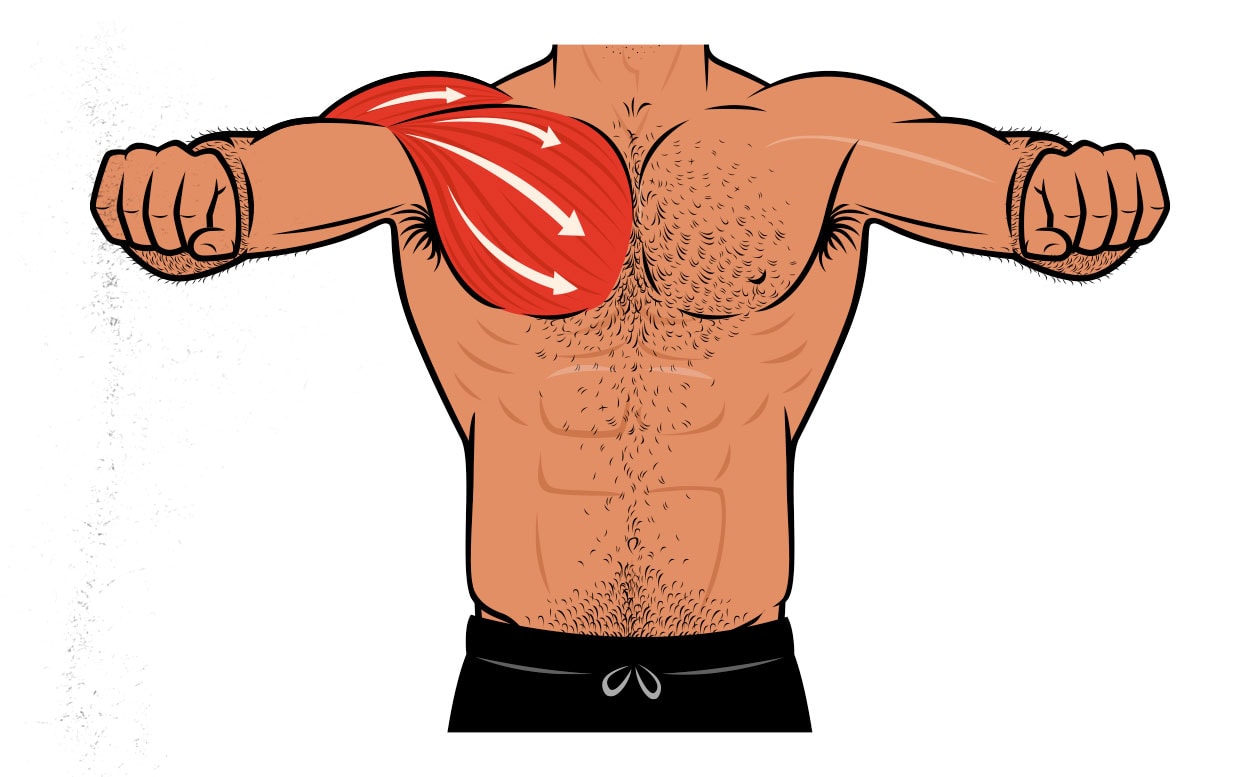
Let’s consider the bench press, the king of chest exercises. Our pecs are simple muscles. They help us hug and push. And the bench press trains that movement perfectly, working our chests in the way they’re designed to work. Not only that but most of us are limited on the bench press by the strength of our chests. That means that we can bring our chests close enough to muscle failure to stimulate muscle growth. No surprise, then, that our chests grow perfectly from the bench press (study).
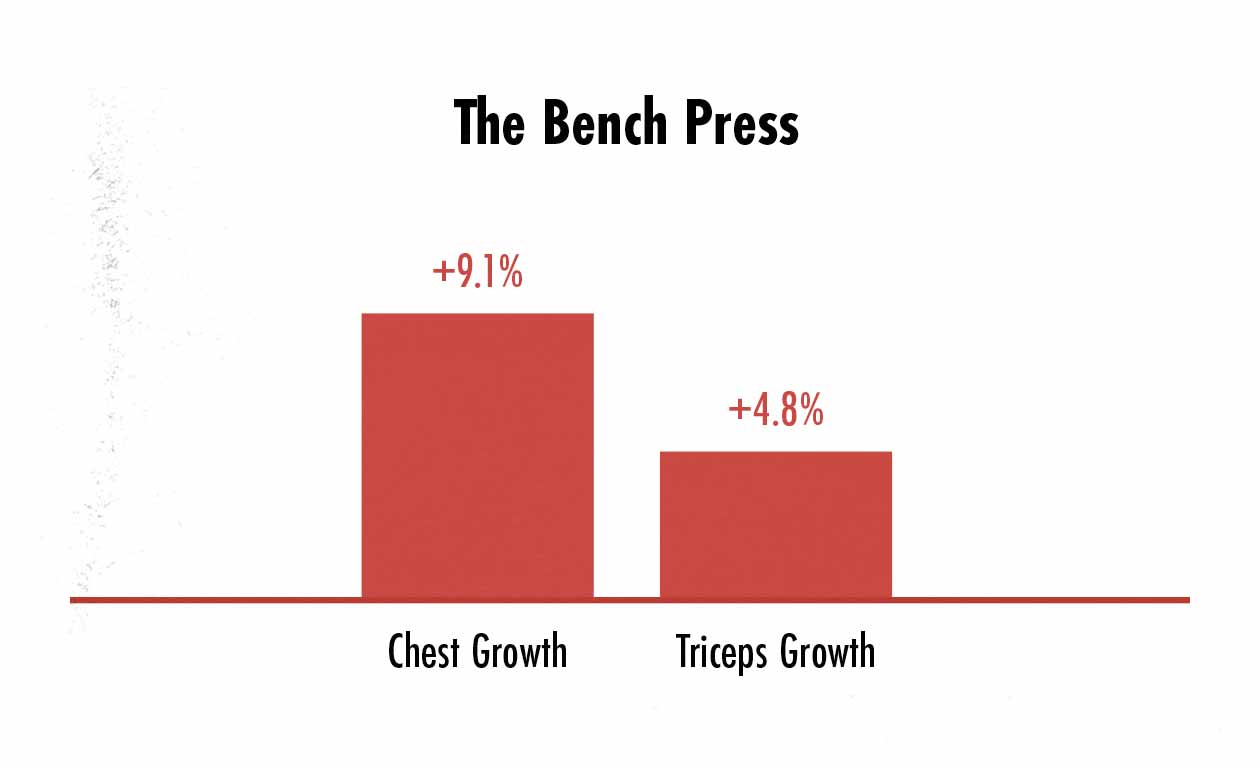
The Importance of Isolation Exercises
Now let’s consider your triceps. They’re a bit more complicated. They cross our shoulder and elbow joints. They help us extend our elbows (as in a triceps extension), but they also help us pull our elbows back (as in a pullover). The bench press does involve elbow extension, and our triceps do help with that, but it also involves shoulder flexion, which our triceps interfere with. As a result, the bench press doesn’t train the triceps properly. Plus, most of us aren’t limited by our triceps strength on the bench press, making it hard to work them hard enough to stimulate muscle growth.
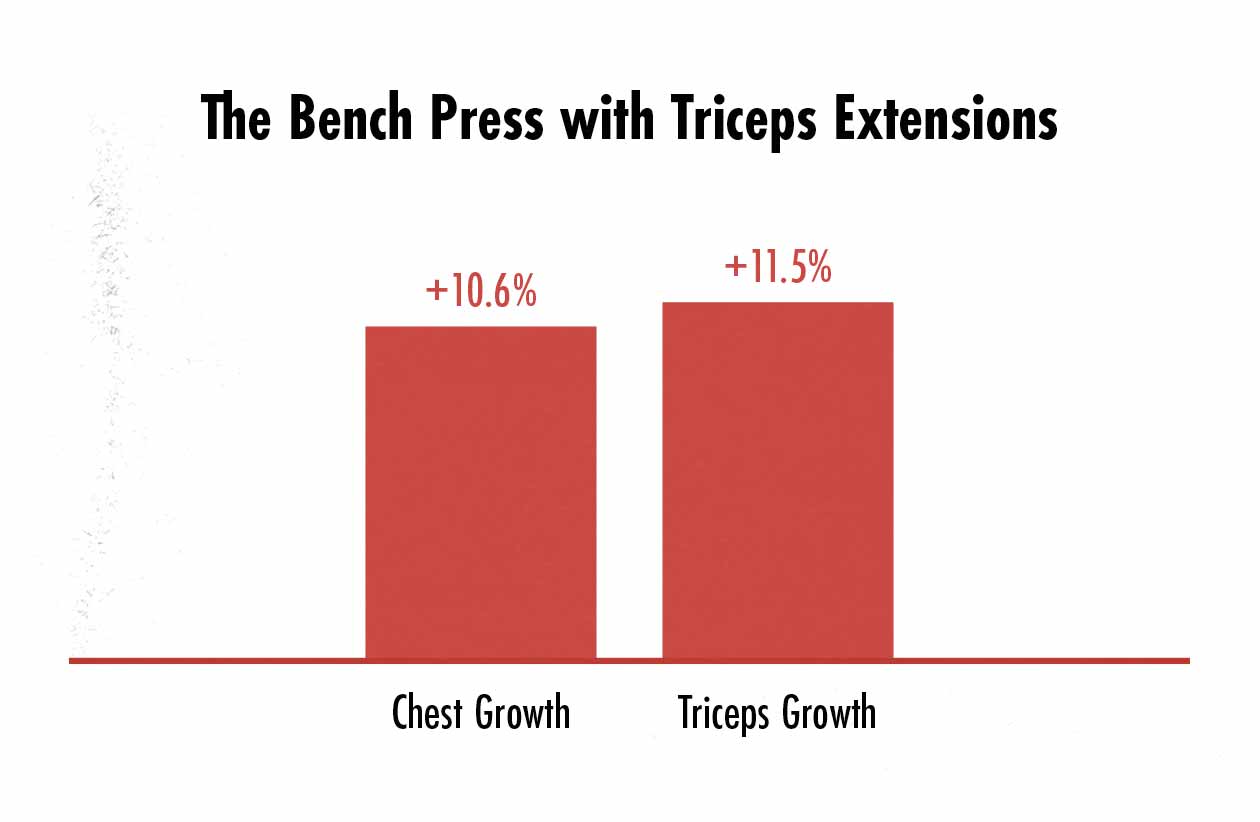
So the bench press is a complete lift for our chests but not our triceps. That’s where the skull crusher comes in. The skull crusher combines elbow extension and shoulder extension, training the triceps in the way they’re designed to work. And our triceps are also our limiting factor, making it easy to work them hard enough to stimulate muscle growth.
The Best Barbell Exercises for Every Muscle Group
So what we want to do is consider every major muscle in our bodies, choosing the exercises that work best. We can start with the biggest muscles and work our way down:
- Quads: barbell squats, such as front squats.
- Glutes: barbell deadlifts, such as conventional deadlifts.
- Calves: barbell calf raises.
- Hamstrings: Romanian deadlifts.
- Shoulders: overhead press.
- Chest: barbell bench press.
- Upper chest: incline or close-grip barbell bench press.
- Lats: chin-up and barbell row.
- Triceps: skull crusher or overhead triceps extension.
- Traps: deadlift, overhead press, barbell row.
- Biceps: barbell curl.
- Spinal erectors: deadlifts (lower back) and front squats (upper back).
- Forearms: forearm curls and extensions.
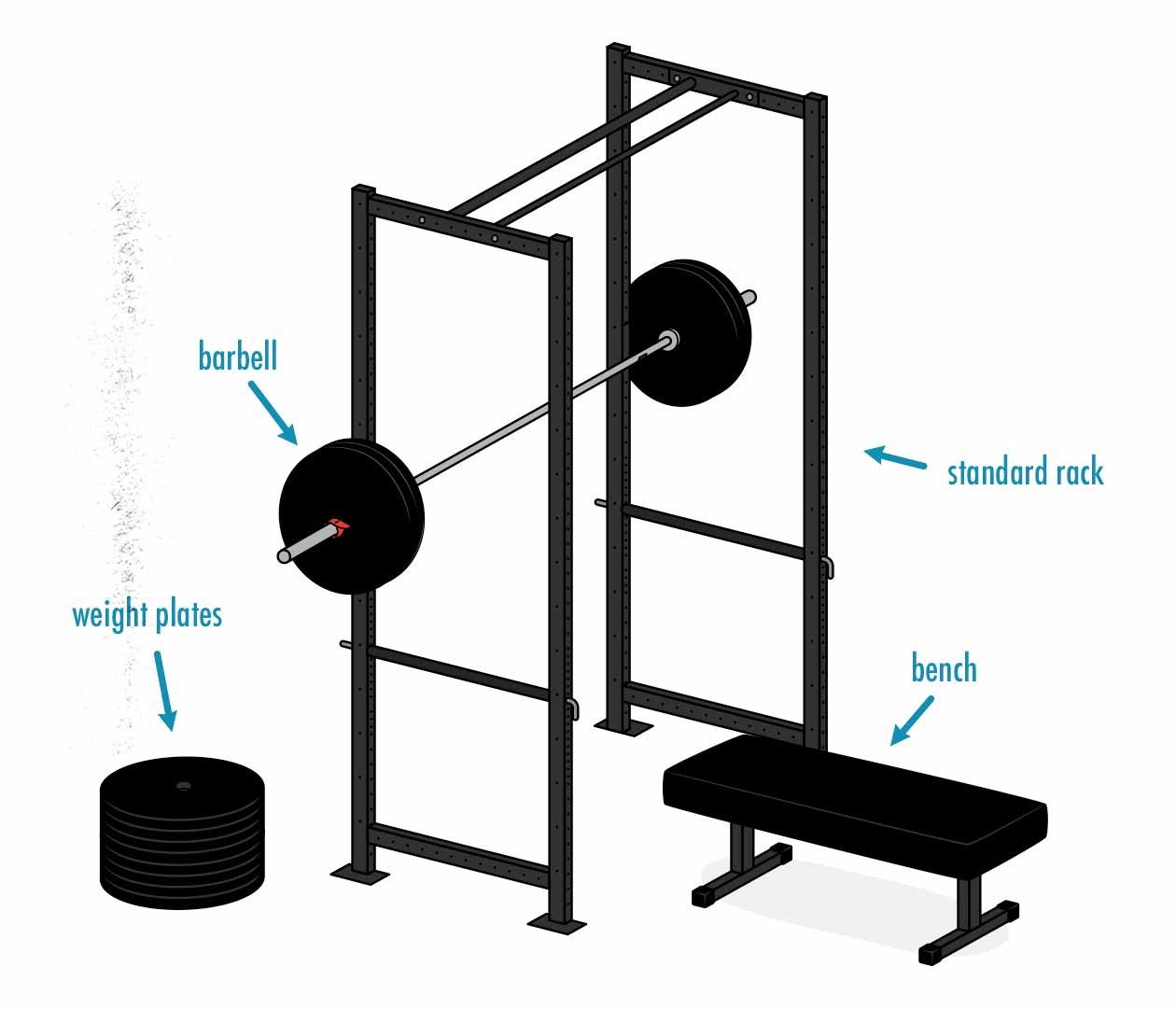
Note: not all of these lifts are barbell lifts, but all can be done in a standard barbell home gym. For example, goblet squats are typically done with dumbbells or kettlebells, but you can do them just as easily with a weight plate. Chin-ups aren’t a barbell exercise either, but you can still do them in your squat rack.
Choose Your Own Priorities
You don’t need to emphasize all your muscles all of the time. In fact, which muscles you target with isolation lifts is almost entirely a matter of personal preference. I actually forgot that calves existed until I saw that they were one of the biggest muscles in our bodies. Needless to say, I haven’t been doing any calf raises, ever, in my entire life. And even so, I’m not crippled by muscular imbalance.
The trick is to make sure that for every muscle you’re interested in growing, you include a lift that works that muscle properly. So if you want bigger arms, don’t rely on the bench press and chin-ups. Those lifts don’t fully engage those muscles or bring them close enough to failure. You’ll want to include barbell curls, triceps extensions, forearm curls, and forearm extensions. Those are the barbell lifts that work those muscles best.
And you don’t need to do all of those lifts forever. Even if isolation lifts are needed to make a muscle bigger, compound lifts are often enough to maintain their size and strength. So the bench press might not be ideal for building bigger triceps, but it’s certainly enough to maintain the size of your triceps. If you want to get rid of skull crushers, no problem. Your triceps won’t shrink. The bench press will maintain them just fine.
The Big Barbell Exercises
We’ve already gone over the best exercises for each muscle, but there’s some nuance to it, too. Squats are best for our quads, sure. But should you do a low-bar back squat, a high-bar back squat, a goblet squat with a weight plate, or a front squat? There are many different options, each with its own pros and cons.
So let’s go through each of the barbell lifts, choosing the best default variations and then giving some good alternatives and variations.
The Barbell Squat
The squat is a knee-dominant exercise that’s amazing at working our quads. In every variation of the squat, our quads are worked through a good range of motion and are usually the limiting factor. Still, there are a few different variations of the barbell squat, each designed for a different purpose.
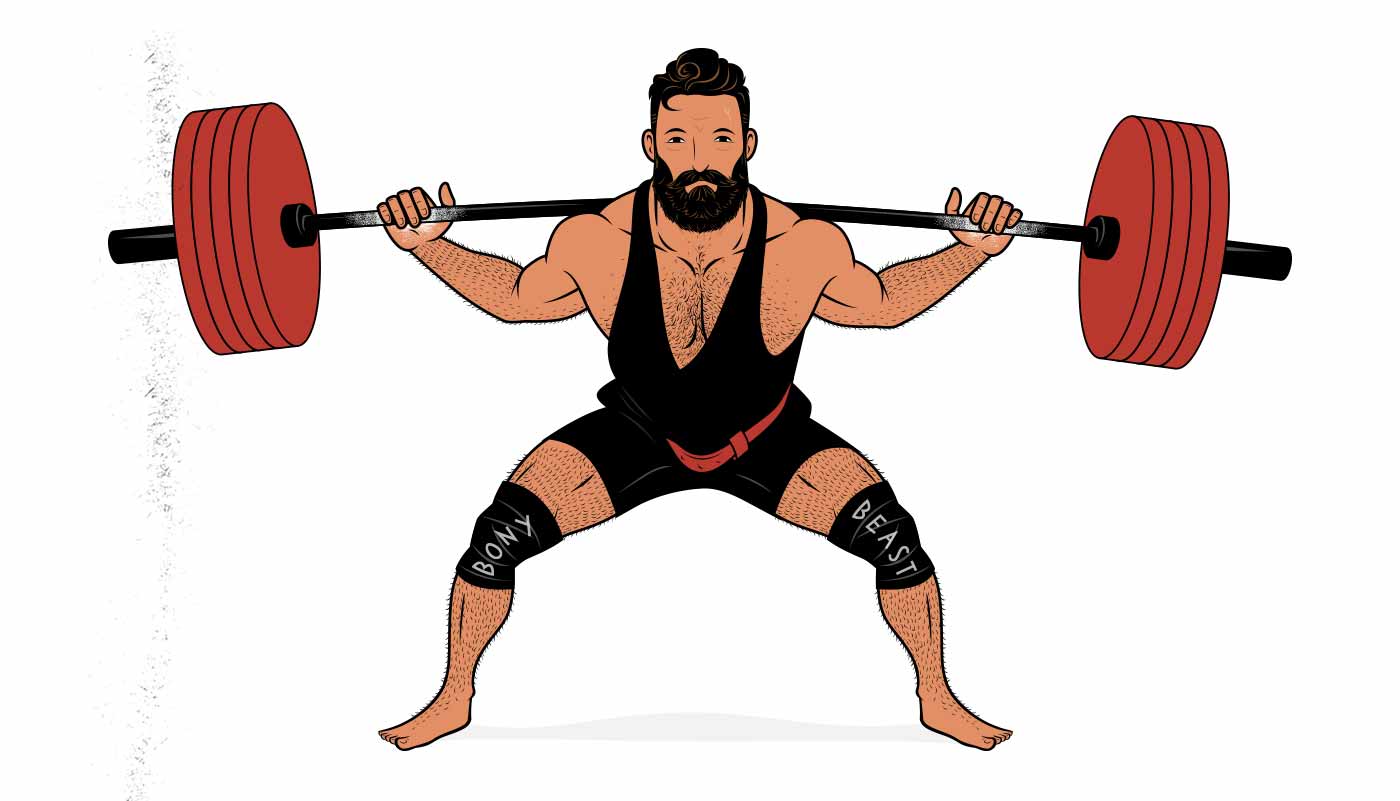
Powerlifters favour the low-bar back squat because it allows them to lift the most weight. The problem is, it uses a larger range of motion for the hips, a smaller range of motion at the knees. If we want to use this as the main lift for our quads—and we do—then we’re better off choosing a more knee-dominant variation.
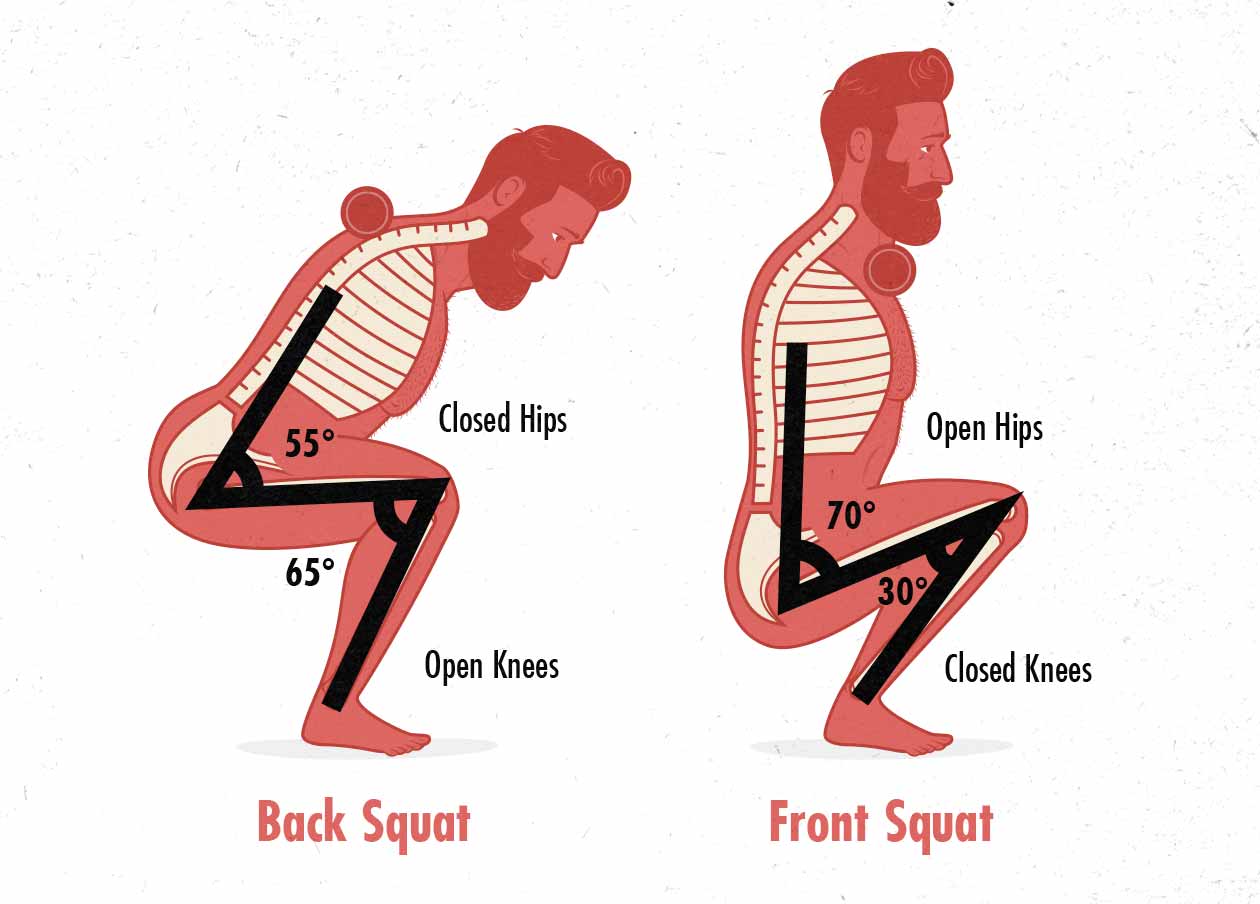
For building muscle, the front squat is often better. When we hold the weight in front of us, it keeps our torsos more upright, allowing us to sink deeper, working our quads through a larger range of motion. This deeper range of motion means that we can’t lift as much weight, which is a downside for powerlifters. But for building muscle, it’s perfect—we do a better job of training our quads with a lower risk of injury and less fatigue.
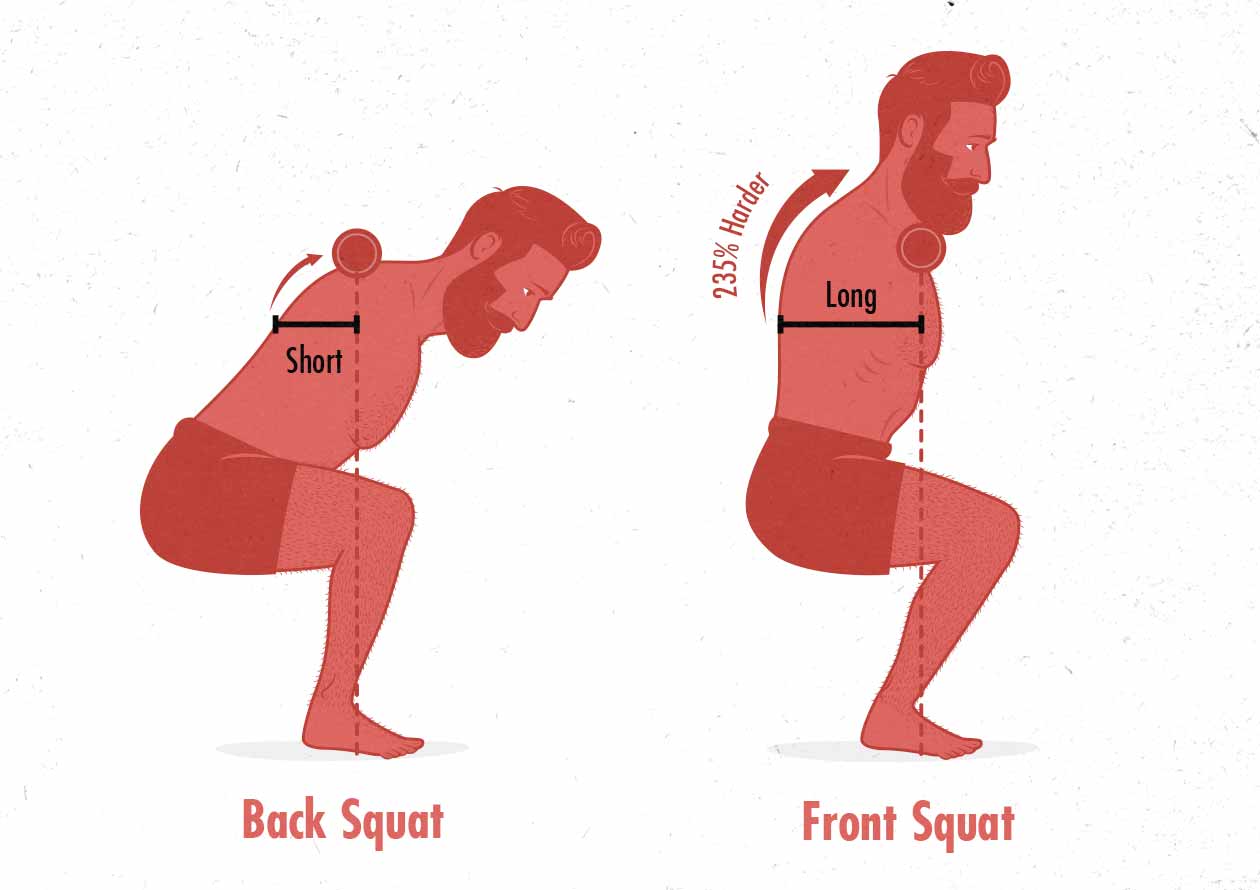
The second benefit to front squats is that holding the weight in the crook of our shoulders demands quite a bit of strength from the postural muscles in our upper backs. They’re often worked hard enough to see quite a lot of growth, improving our posture, strength, and appearance.
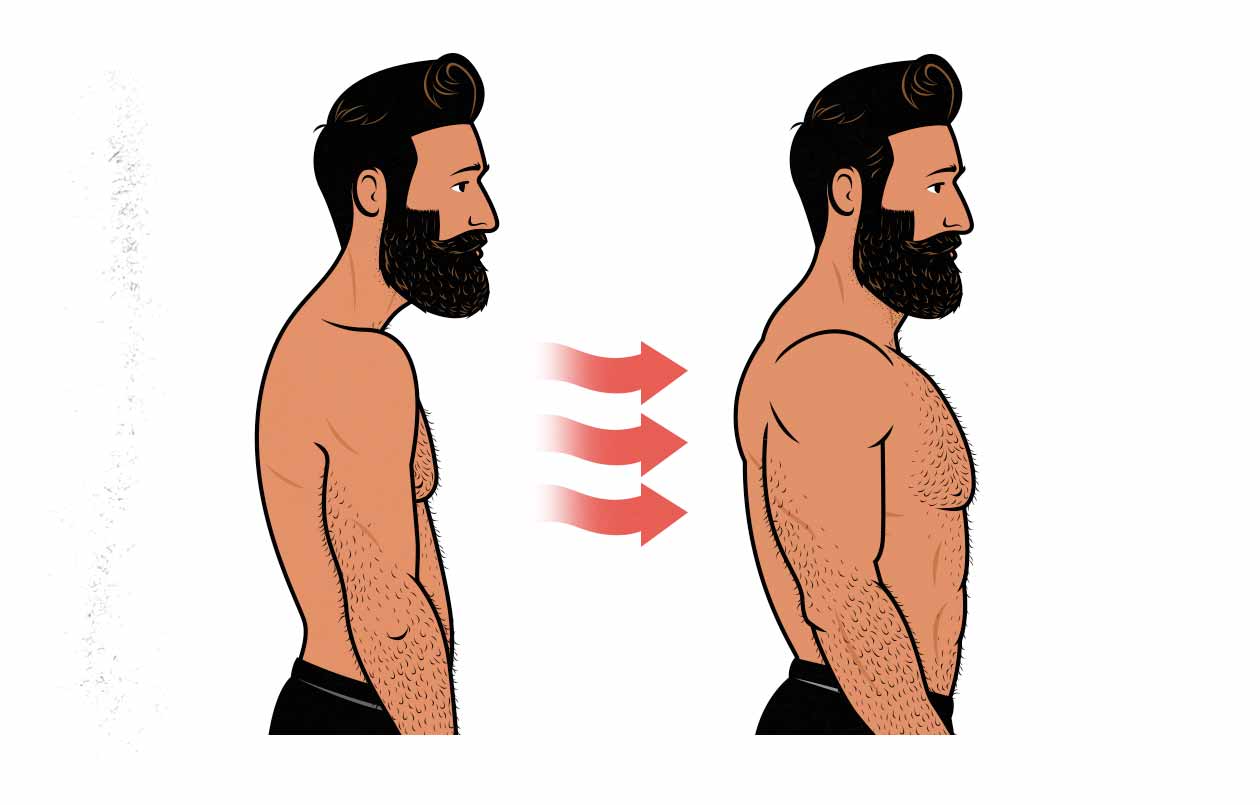
The third benefit of front squats is that they’re easier on our lower backs. That might not sound like a benefit at first. After all, we want to bulk up our lower backs. But with barbell training, our lower backs tend to be worked quite hard by a variety of different lifts: deadlifts, barbell rows, and squats. And when our lower backs are tired, that can hamper our performance on almost every barbell lift, ranging from the overhead press to the barbell curl. So by choosing a squat variation that’s easier on our lower backs, we’re less likely to overwork those muscles.
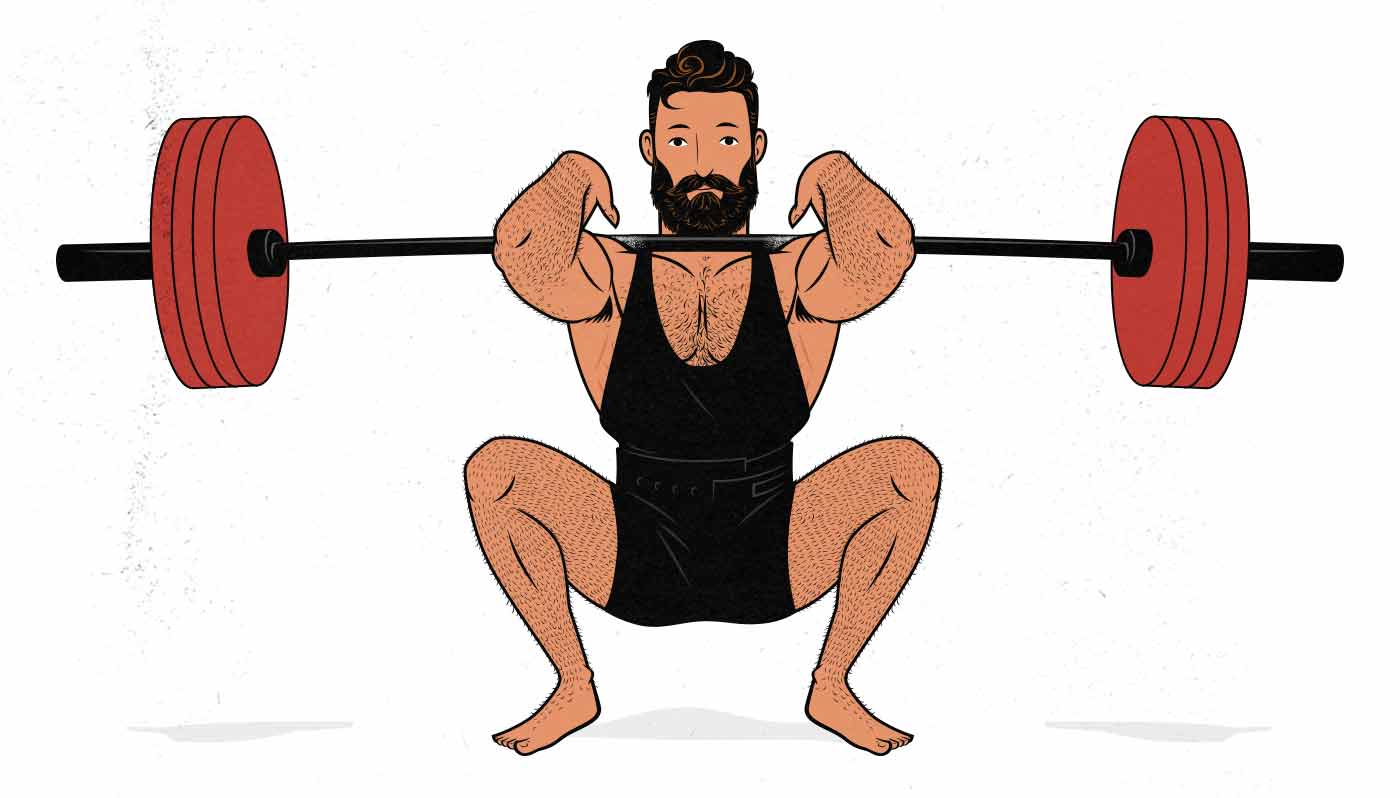
That isn’t to say that the front squat is the only good variation, though. Some people don’t like the intense forearm pain or simulated strangulation that the front squat is infamous for. Those issues fade with a bit of practice, but even so, it’s common for people to prefer the high-bar squat. It’s not quite as good for the upper back, but it still works the quads through a large range of motion. It’s a great choice.
It’s also good to have a bit of squat variety in your routine. Maybe you do the front squat on Monday, the back squat on Friday. Using a wider variety of lifts tends to yield more balanced muscle growth, more versatile strength gains, and it eases the repetitive strain on your joints.
The best barbell squat variations & alternatives:
- Front squats (ideal default)
- High-bar back squats
- Low-bar back squats
- Barbell split squats
- Zercher squats
The Barbell Bench Press
The bench press is the best chest exercise. It works all of the muscle fibres in our chests through a deep range of motion, and it works them more than hard enough to stimulate a maximal amount of muscle growth. It’s possible to be limited by shoulder or triceps strength. But done properly, the bench press can be a perfect chest exercise for most people.
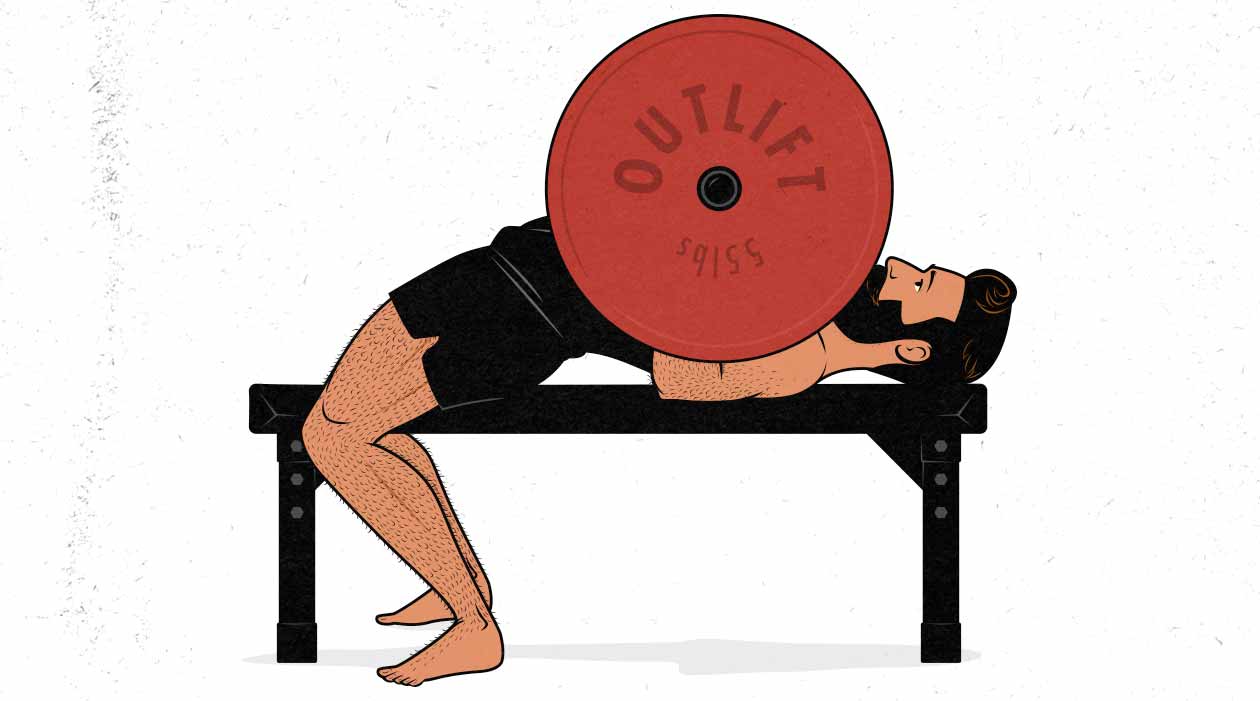
Powerlifters know how to bench for muscle growth. With some of these lifts, we’re veering away from strength training to make the lifts better for building muscle. But with the bench press, there’s a lot we can learn from powerlifters. Using at least a modest arch tends to work our chest harder, and without reducing the depth of the range of motion. (Arching means bringing our torsos up to meet the bar, which stretches the chest just as much as bringing the barbell down to meet our torsos.)
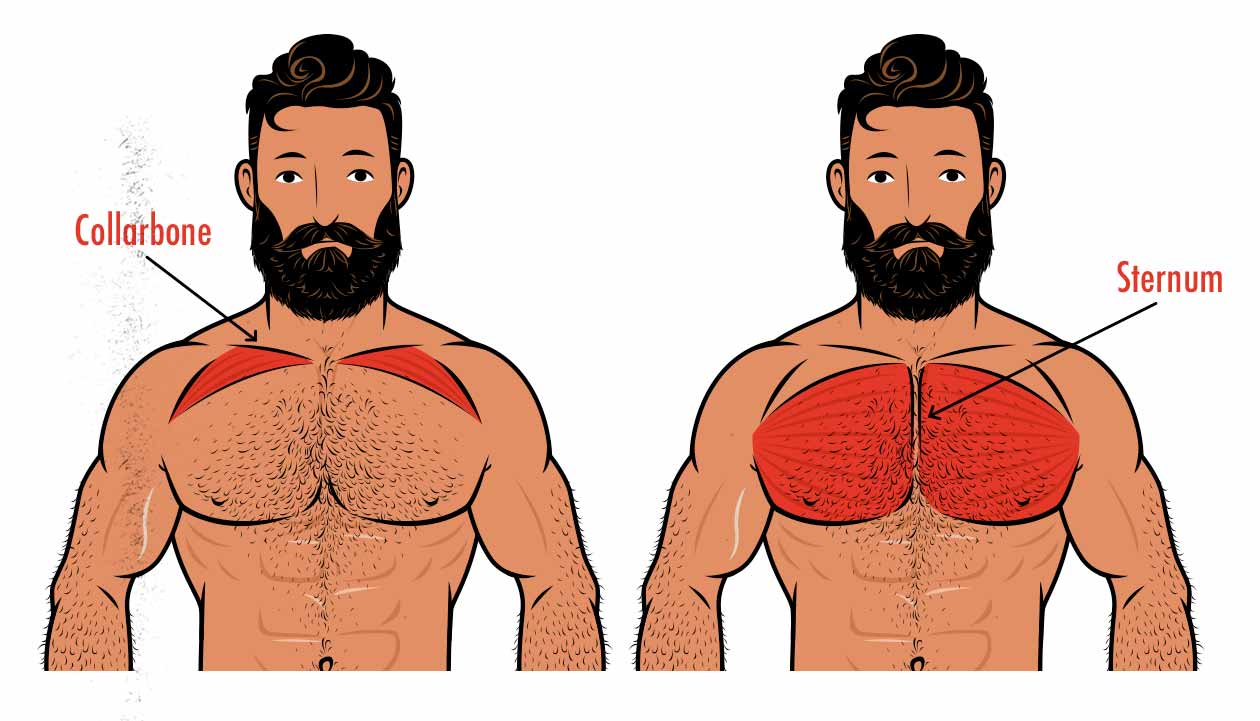
The trick with the bench press is finding the grip width that causes our chests to become the limiting factor. The narrower we grip the barbell, the harder we work our shoulders, upper chest, and triceps, which is great, but we want to make sure that the main muscles in your chest—the sternal fibres in our lower and mid chests—are still the limiting factor. That’s how we stimulate the most overall chest growth.
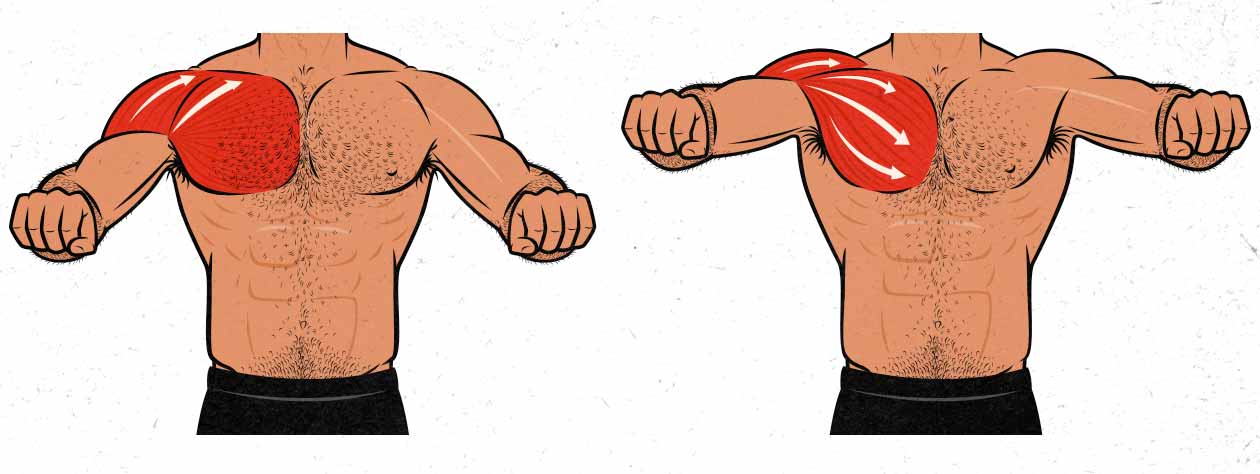
A good rule of thumb is to use the narrowest grip where your chest strength still limits you. For me, that’s with my pinky fingers about an inch inside the bench press rings. My upper chest and shoulders are still worked hard enough to get sore, but the emphasis is on my mid and lower chest, where most of the muscle mass is.
The best barbell bench press alternatives:
- Barbell bench press
- Wide-grip bench press
- Close-grip bench press
- Pause bench press
- Deficit push-ups (with hands raised on weight plates)
The Barbell Deadlift
The deadlift is a hip-dominant exercise that works our glutes through a full range of motion. It’s ideal for working our butts and lower backs, but it’s also great for working our hamstrings, traps, and various other upper back muscles. Different muscles limit different people in the deadlift, but it’s usually a toss-up between the glutes and spinal erectors, making it fairly ideal for bulking up both.

The deadlift variation that allows most people to lift the most weight is the sumo deadlift. It lets us sneak our hips in closer to the bar, it brings in more of our quads, and it makes the lift easier on our back. If we want a lift that emphasizes our glutes, quads, and upper traps, this is a good choice. But it’s often better to use the deadlift as a hip and back exercise, which is where the conventional deadlift shines.
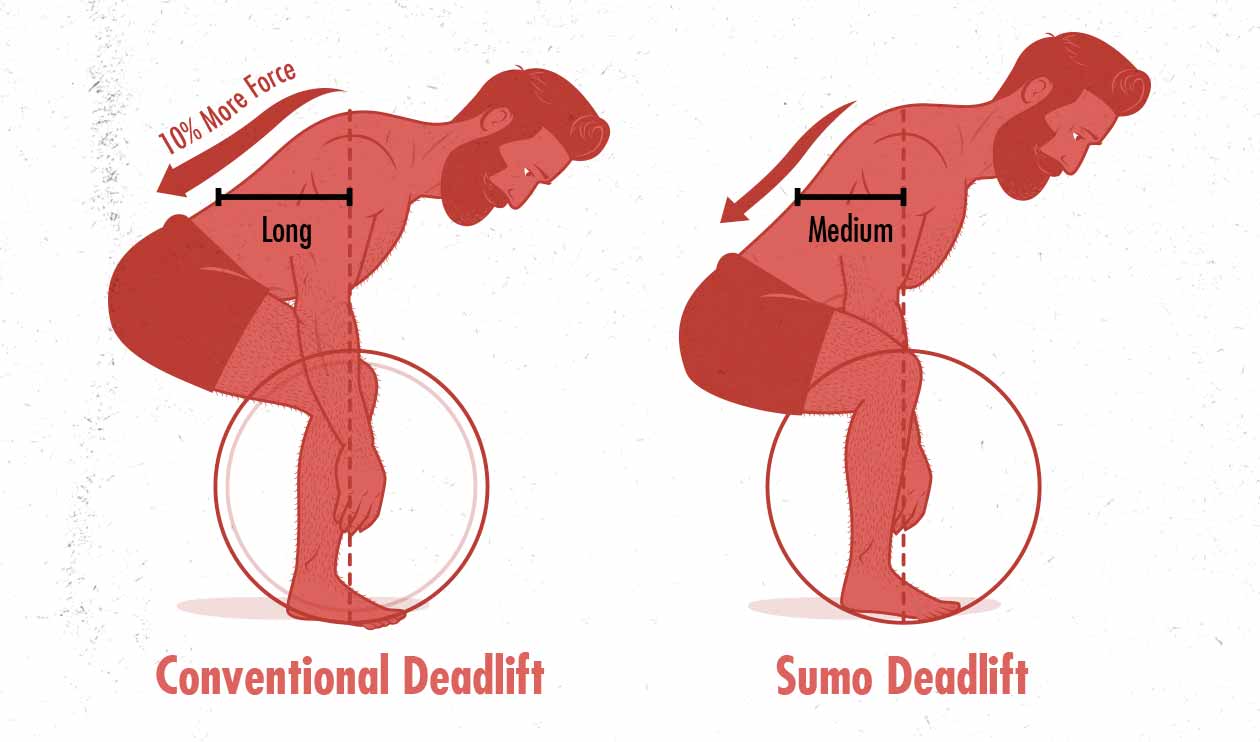
The conventional deadlift tends to be better for building muscle. With the conventional deadlift, we’re working our hips and hamstrings through a larger range of motion, and we’re also putting more tension on our spinal erectors and mid and lower traps. That makes it the better all-around lift for building muscle, for most people, in most cases.
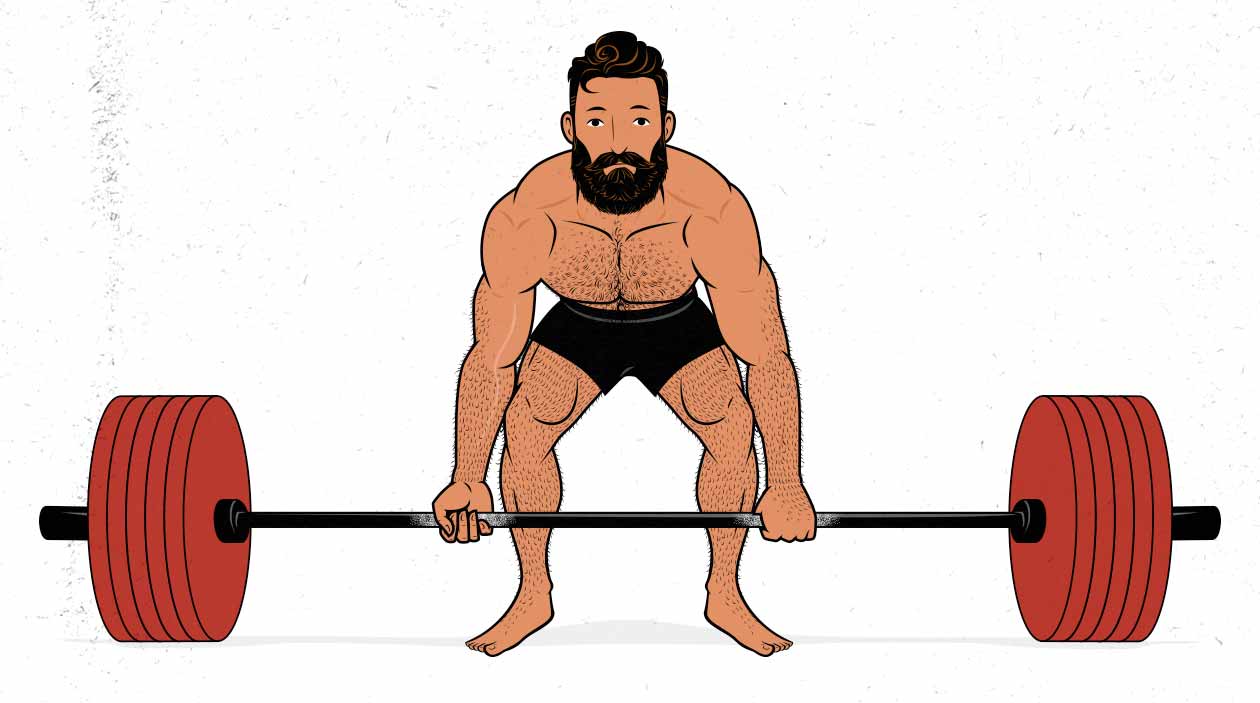
Another deadlift variation is great for building muscle, too: the Romanian deadlift. With this variation, we start from a standing position and move our hips backwards (without much knee bend) until we have a full stretch on our hamstrings, typically around knee height. It’s quite a bit lighter than the conventional deadlift, it’s easier on our lower backs, and because it has more bend at the hips and less at the knees, it’s amazing for building bigger hamstrings and glutes.
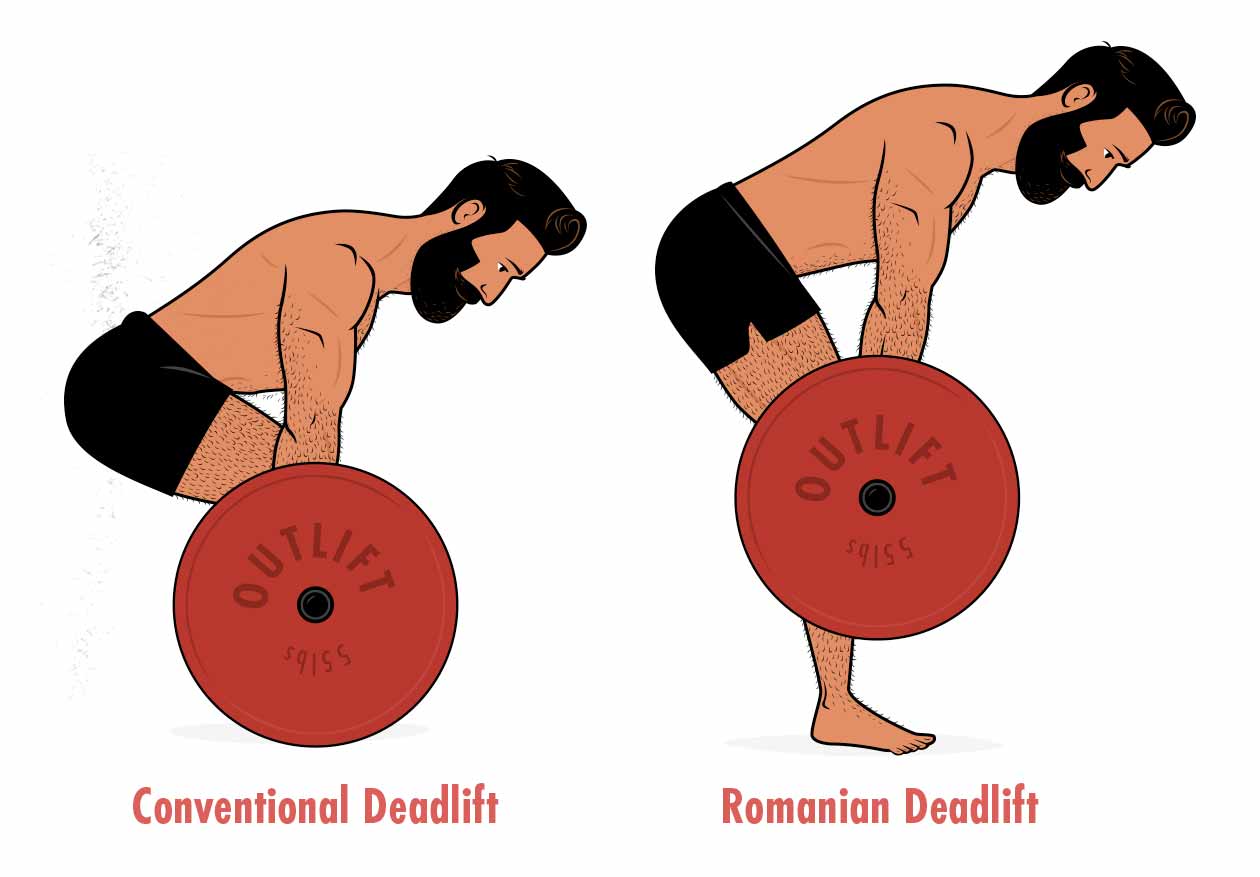
So with the deadlift, we have two great options: the conventional and Romanian deadlift. The conventional deadlift is bigger, heavier, more tiring, emphasizes the back, and stimulates the most overall muscle growth. The Romanian deadlift is smaller, lighter, and less fatiguing, and it does a better job of bulking up the hips and hamstrings. Which you choose is up to you, but you should probably choose both.
The best deadlift alternatives and variations:
- Conventional deadlifts (best for the back and hips)
- Romanian deadlifts (best for the hips and hamstrings)
- Sumo deadlifts
- Single-legged Romanian deadlifts
- Deficit deadlifts
- Snatch-grip deadlifts
The Barbell Overhead Press
The overhead press is our main shoulder lift. There are a few popular lifts for our shoulders, with the incline bench press being one of the most popular. Thing is, the incline bench press only works the fronts of our shoulders, which are also worked by the bench press, push-ups, and most other pushing movements. When we’re choosing a true shoulder lift, we want something that works both our front delts and our side delts. That’s what the overhead press is best for.
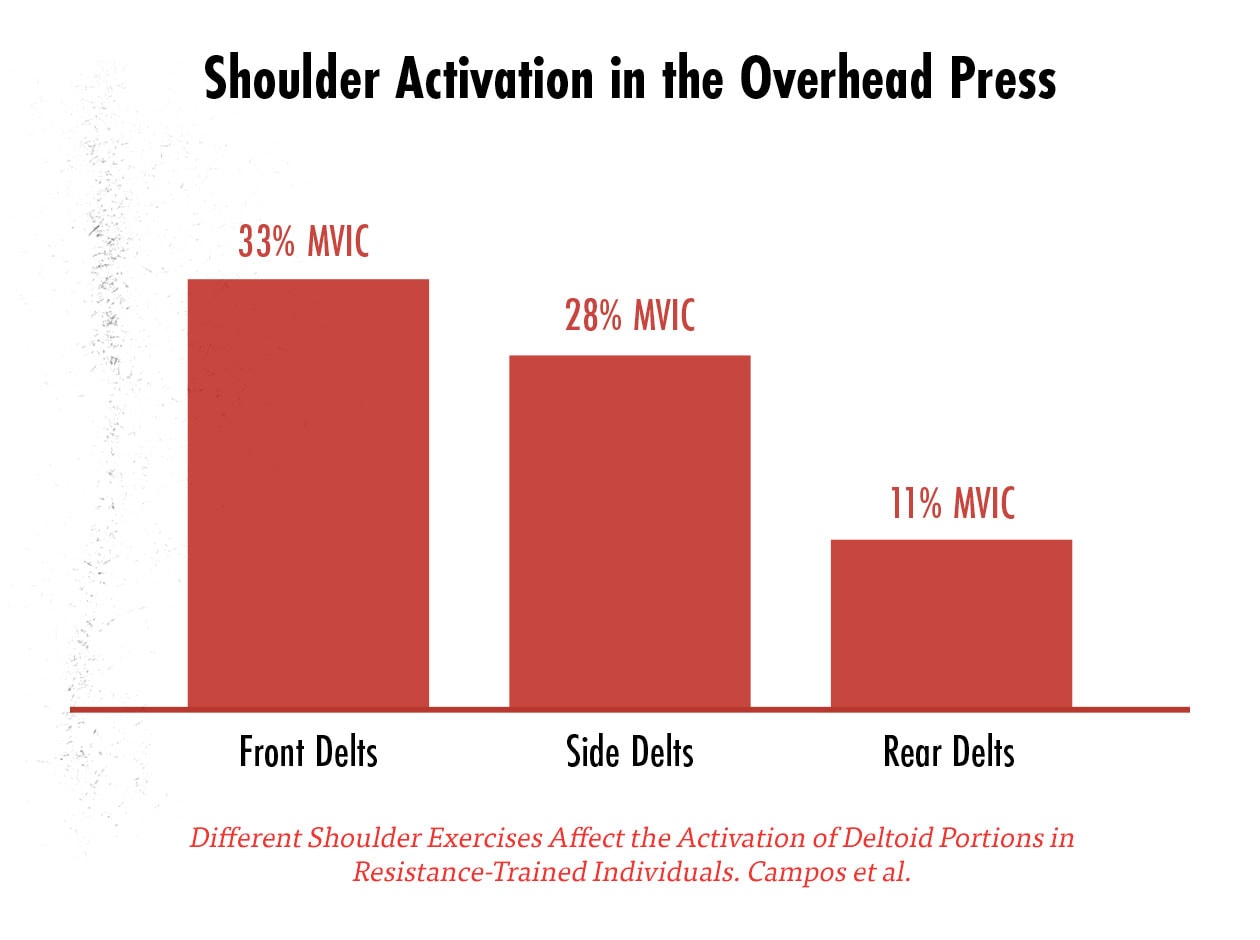
The overhead press works both our front and side delts through a deep range of motion, and it works them hard enough to stimulate a maximal amount of muscle growth. It’s also a great lift for working our upper traps and abs, making it a great all-around muscle-building lift.
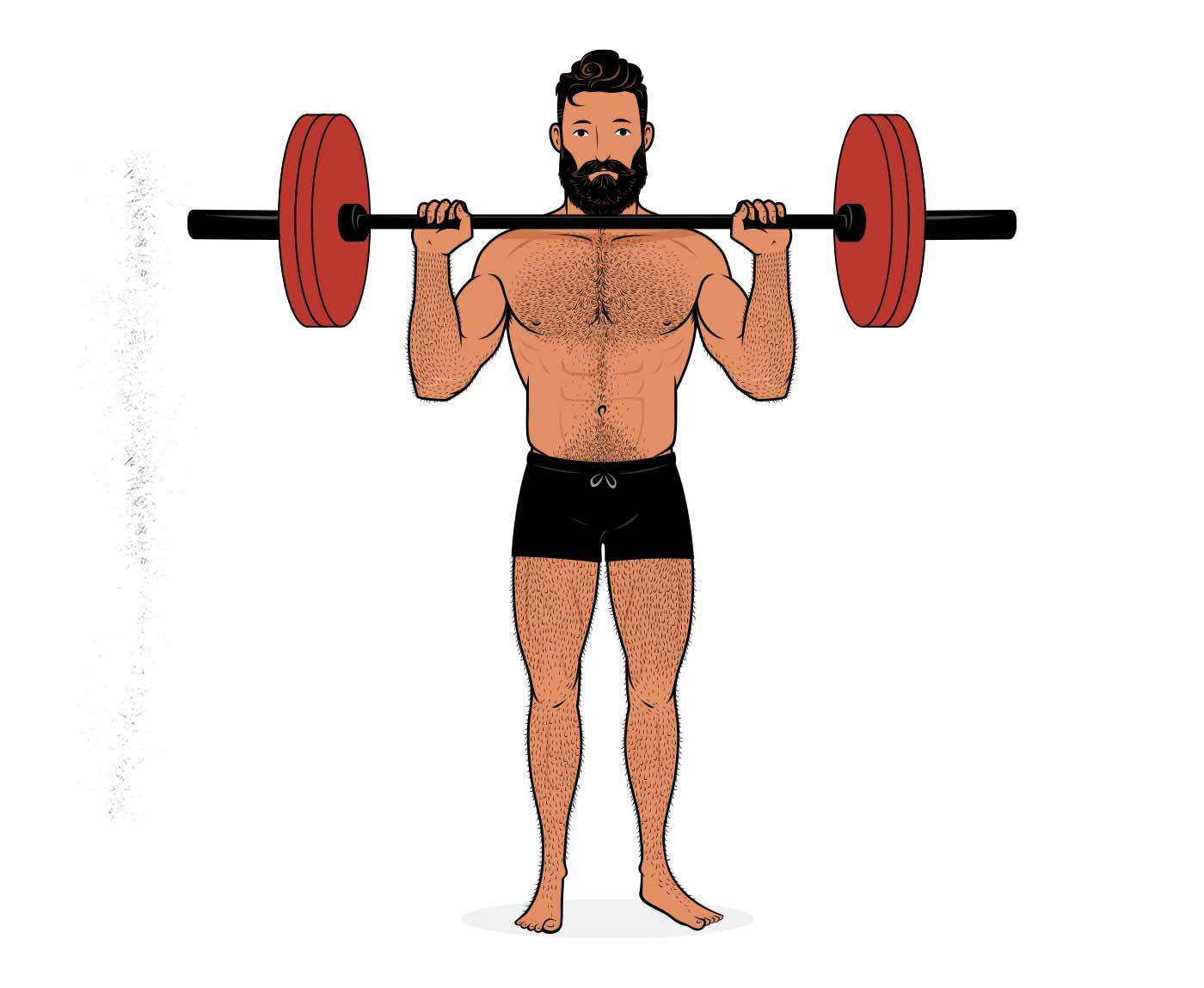
The overhead press’s main downside is that it’s an advanced lift, requiring quite a lot of shoulder mobility and stability. Not everyone can do it right away without kinking their lower backs or grinding up their shoulder joints. If that happens, you might want to start with some deficit push-ups and incline bench pressing to work your front delts, and you can work your side delts with weight-plate lateral raises.
The best barbell overhead press variations and alternatives:
- Standing barbell overhead press
- Push press
- Incline bench press
- Deficit push-ups
- Weight-plate lateral raises
The Chin-Up
The chin-up is our main upper-back lift. Most barbell programs, including both Starting Strength and StrongLifts 5×5, avoid the chin-up, at least at first, opting for power cleans or barbell rows instead. And there’s some wisdom behind that.
Most strength training programs are rooted in powerlifting, and powerlifters need to develop very strong hips and lower backs. That’s why hip-dominant back lifts, like the power clean and Pendlay barbell row, work so well. They’re designed to emphasize hip and lower back strength, with a bit of upper-back growth coming along for the ride.
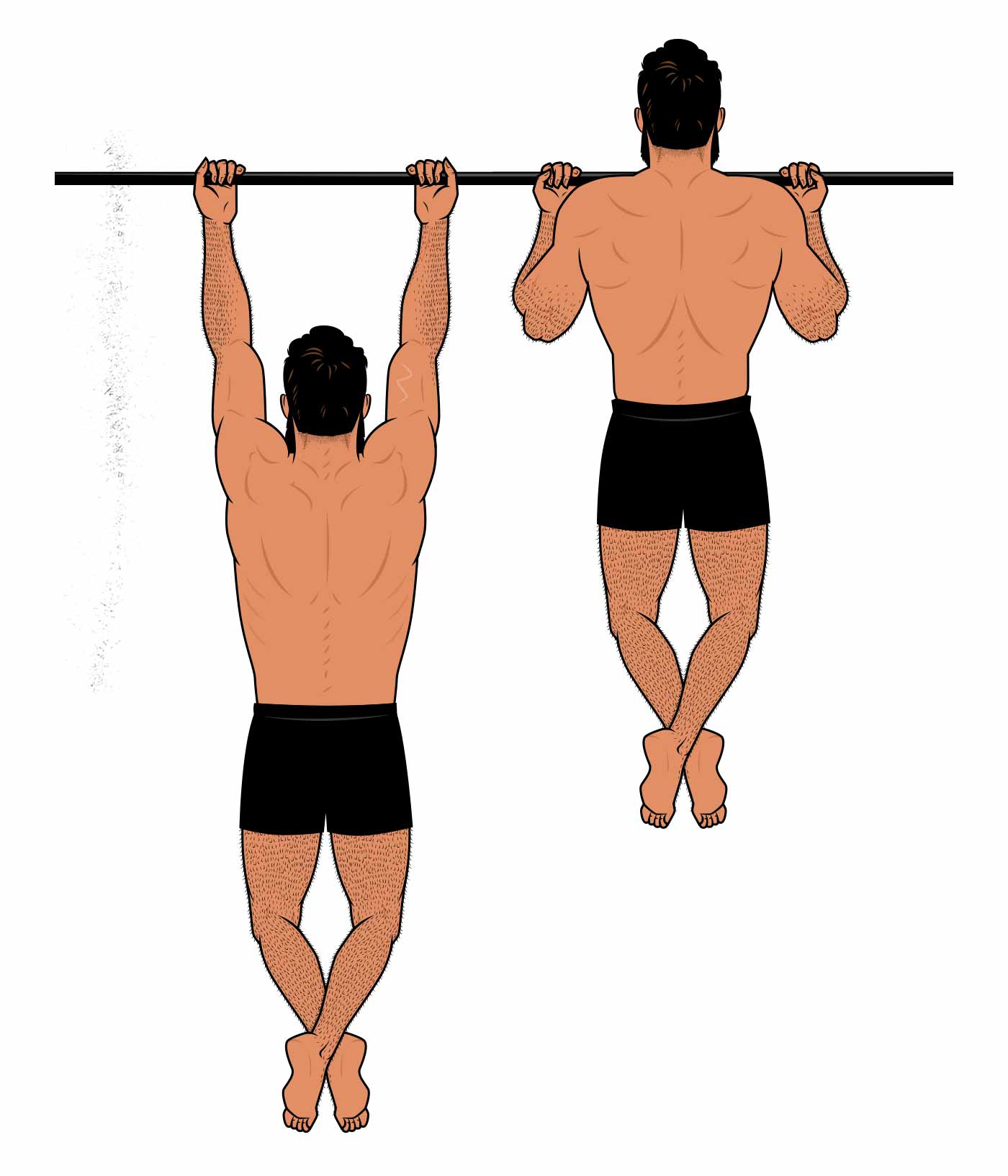
But we aren’t powerlifters, so instead of choosing an exercise for our hips and lower backs, we’re choosing an exercise for our biceps and upper backs—the chin-up. With the chin-up, not only are our upper backs the limiting factor, but they’re also worked through a much deeper range of motion, and with a much better strength curve. This makes chin-ups a much better lift for our upper backs, and a pretty decent lift for our biceps, too.
The best chin-up variations and alternatives are:
- Neutral-grip chin-ups
- Angled-grip chin-ups
- Gymnastic-ring chin-ups
- Pull-ups (overhand grip)
- Barbell rows
- Barbell pullovers
The Small Barbell Exercises
The big barbell lifts train all of the biggest muscles in our bodies, and they do it very well. They’re incredibly efficient exercises. But as we mentioned above, the big compound barbell lifts can only take us so far. If we want to build muscle and strength evenly throughout our bodies, we also need to include lifts that are ideal for the muscles in our limbs—for our biceps, triceps, hamstrings, forearms, calves, and necks.
The Barbell Curl
The best barbell exercise for building bigger biceps is the barbell curl. These are a simple lift. All we do is curl the barbell upwards. But it’s actually a surprisingly large lift, working our biceps through a large range of motion while also challenging our forearm flexors (to keep our wrists from bending backwards) and upper back muscles (to keep our torsos from caving inwards).
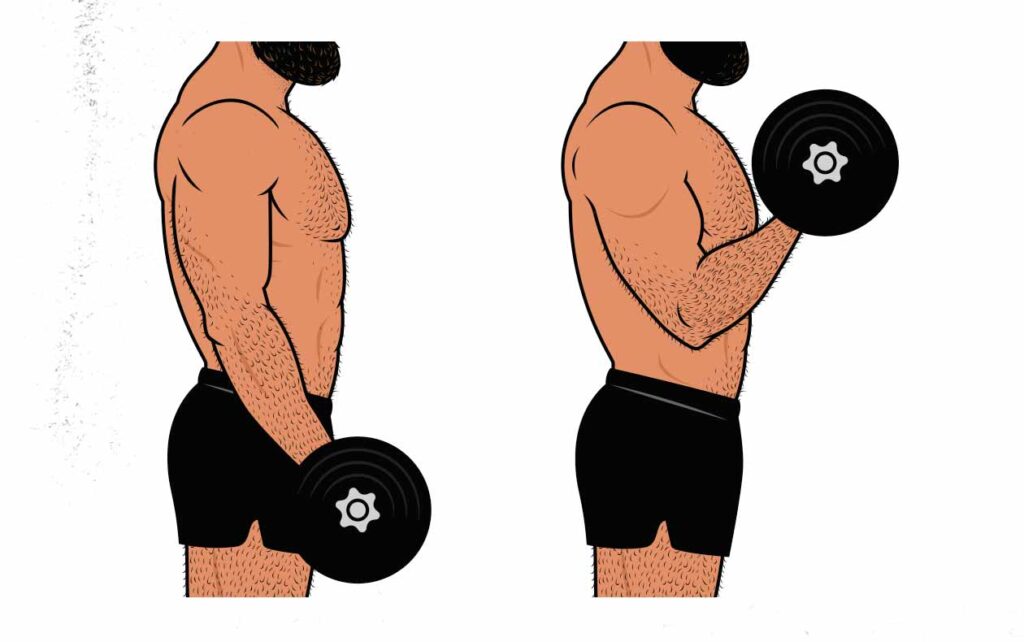
The reason that barbell curls are so important is that our biceps cross both our elbow and shoulder joints. They don’t just flex our arms, they also bring our elbows forwards. That means that with compound exercises like the chin-up and barbell row, our elbows are moving the wrong direction—backwards instead of forwards. That prevents the biceps from fully engaging, from working through a full range of motion.
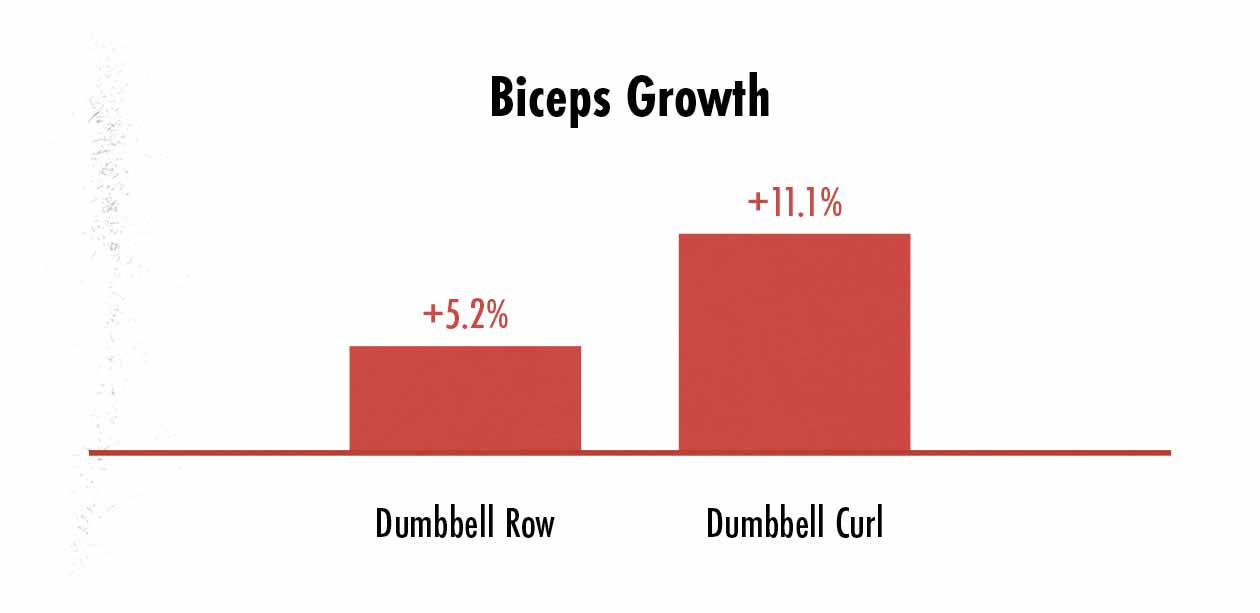
In this study, biceps curls produced twice as much muscle growth as rows, even though the rows were done with an underhand grip. Chin-ups challenge our biceps quite a bit more, but even so, they’re no match for dedicated biceps curls. Plus, without curls, we don’t have a single lift in our routine that challenges our forearm flexors.
In a way, we can think of the biceps curl as a “compound” lift for the muscles that flex our arms, training both our elbow flexors (biceps, brachialis, and brachioradialis) and the myriad wrist flexors in our forearms.
The best barbell curl variations and alternatives:
- Strict barbell curls
- Barbell cheat curls
- Curl-bar curls
You’ll notice that we’re mentioning curl-bar exercises here. You don’t need to use those variations, but if your elbows hurt when doing standard barbell curls, that’s a good way of solving the problem.

For all of these smaller exercises, you can get away with using a standard barbell, but it helps to get a curl-bar or “EZ-Bar” (such as this one from Rogue). These smaller, angled barbells make it more convenient to do smaller barbell lifts, ranging from biceps curls to triceps extensions to pullovers. Plus, having a second barbell means that you can do your exercises in supersets, making your workouts much shorter. They use the same weight plates and collars, making them a simple addition to a barbell home gym.
The Barbell Skull Crusher
The skull crusher is the best barbell exercise for building bigger triceps. As we covered above, our triceps extend our elbows while moving them back. Lifts like the bench press extend our elbows while moving them forwards, preventing our triceps from fully engaging. That’s where the skull crusher comes in.
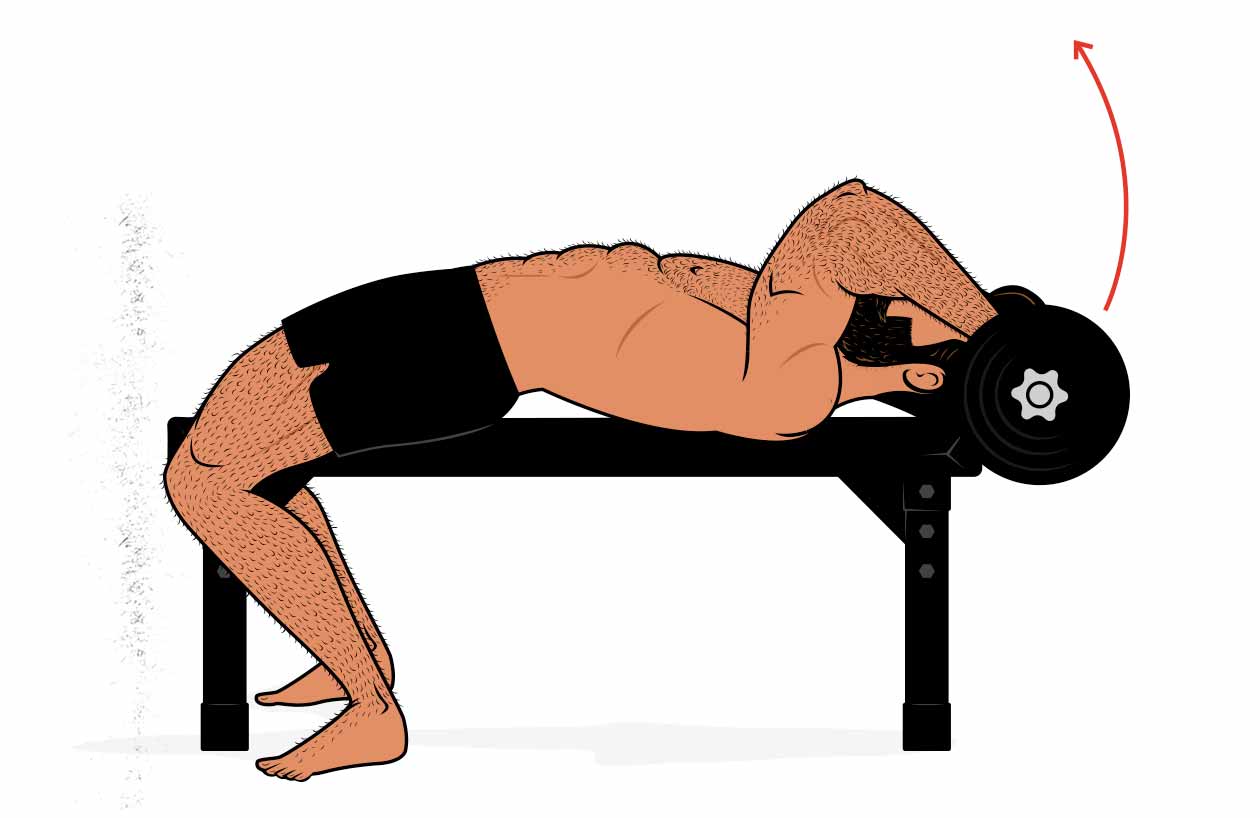
With skull crushers, we’re training both functions of the triceps: elbow and shoulder extension. This allows all three heads of our triceps to engage fully, and it’s why they produce twice as much triceps growth as the barbell bench press. And our triceps are big muscles, too. Nearly as big as our lats and chests (study). So if you want bigger arms, these are the best exercise to add into your workout program.
The best skull crusher alternatives and variations:
- Overhead triceps extensions
- JM press
- Close-grip bench press
The Barbell Romanian Deadlift
The barbell Romanian deadlift is the best barbell exercise for our hamstrings. With our hamstrings, we run into the same problem as we do with our biceps and triceps. Our hamstrings cross both our hips and our knees, so when we do a lift like the deadlift, the movement at the knee interferes with our ability to full engage our hamstrings. That’s where the stiff-legged “Romanian” deadlift comes in.
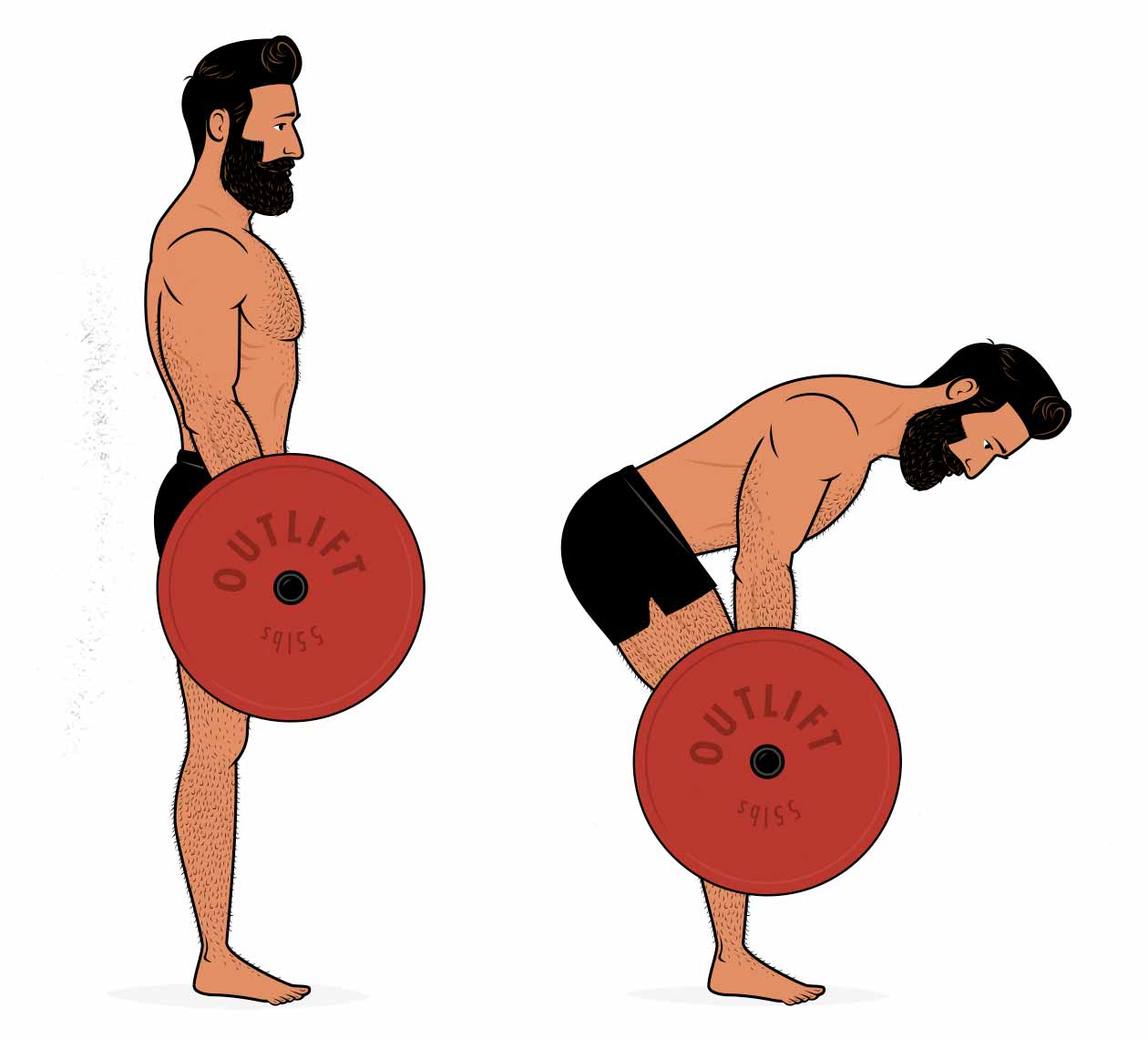
By keeping our knees “stiff,” we can work our hamstrings through a deep range of motion without letting our knee bend unload them. Our knees will bend a little bit, but we still get a full, deep stretch on our hamstrings, and they’ll still able to fully contribute to the lift.
The other advantage to the Romanian deadlift is that they’re quite a bit easier on our lower backs, making them a good lift to alternate in with the deadlift. If we do a few sets of deadlifts one day, and then a few sets of Romanian deadlifts on another, we get a balanced amount of muscle growth in our posterior chains while keeping our overall fatigue in check.
The best Romanian deadlift alternatives and variations:
- Low-bar good mornings
- High-bar good mornings
- Single-leg Romanian deadlifts
- Snatch-grip Romanian deadlifts
Neck Curls & Extensions
To build a bigger neck, do neck curls and extensions with a weight plate. Our upper traps rise on either side of our necks, and they’re trained quite well by deadlifts, Romanian deadlifts, barbell rows, and overhead presses. As a result, most of us won’t need to use shrugs to build fully developed traps.
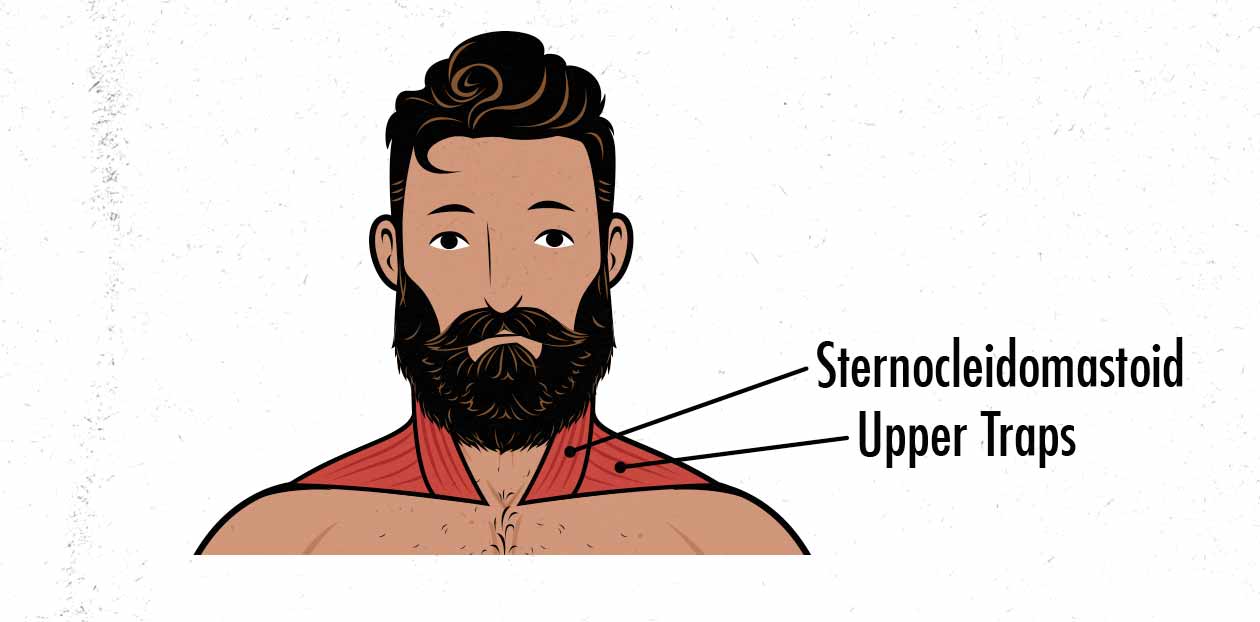
Our necks, though, are an entirely different matter. None of the compound lifts train our neck muscles at all. So unless you include some dedicated neck training in your workout program, expect your neck to stay about the same size.
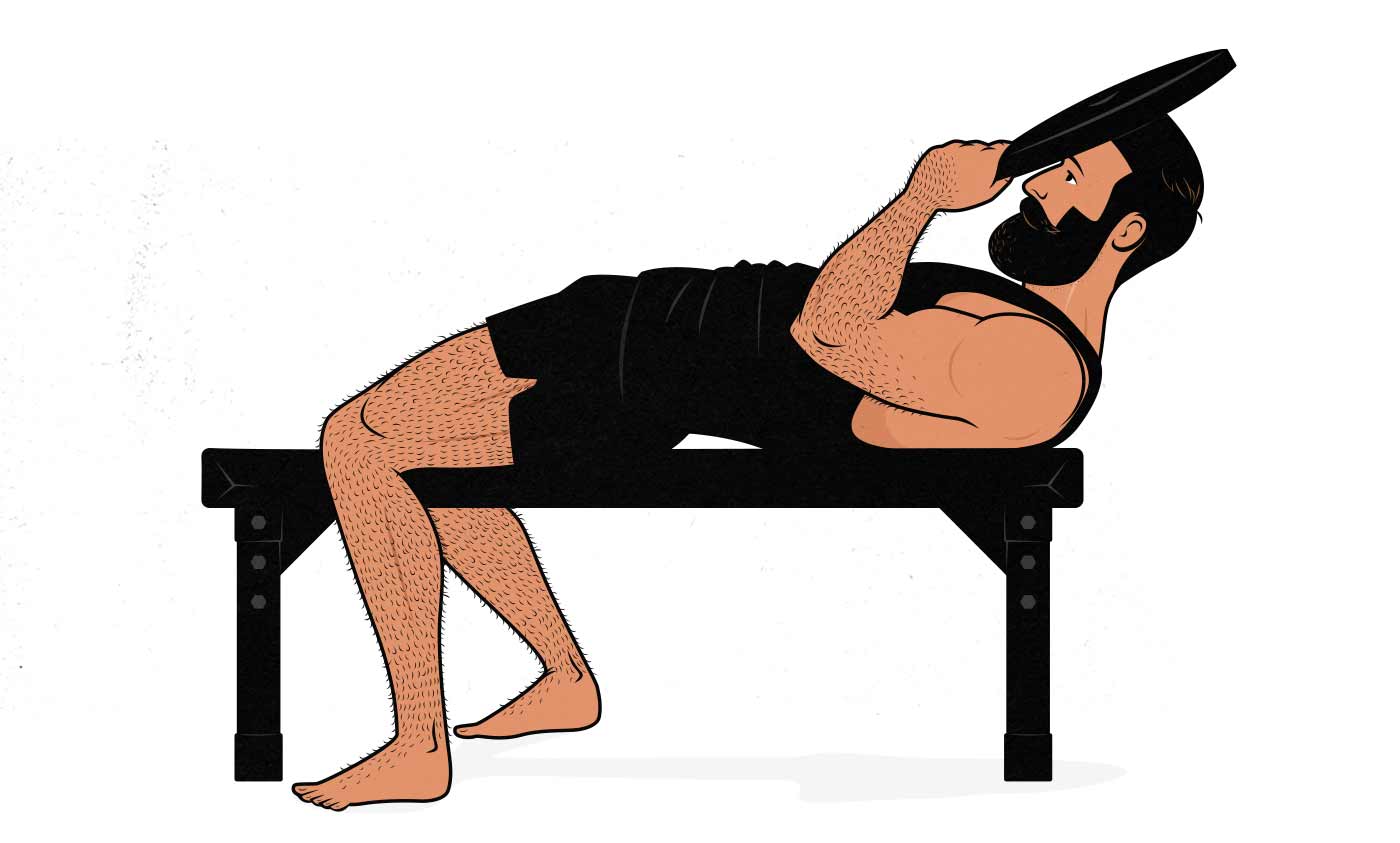
There are a few exercises that can train our necks, and neck bridges are popular with wrestlers and fighters. But the best exercises for building a bigger neck are the neck curl and the neck extension. For more, we have a full article neck training.
Forearm Curls & Extensions
Wrist curls and extensions are the best barbell exercises for building bigger forearms. Our forearms house a few different muscles that are trained by a few different lifts. Barbell rows train our elbow flexors, barbell curls train our wrist flexors, and lateral raises train our wrist extensors. So if you’re doing all of those lifts already, your forearms are probably doing okay.
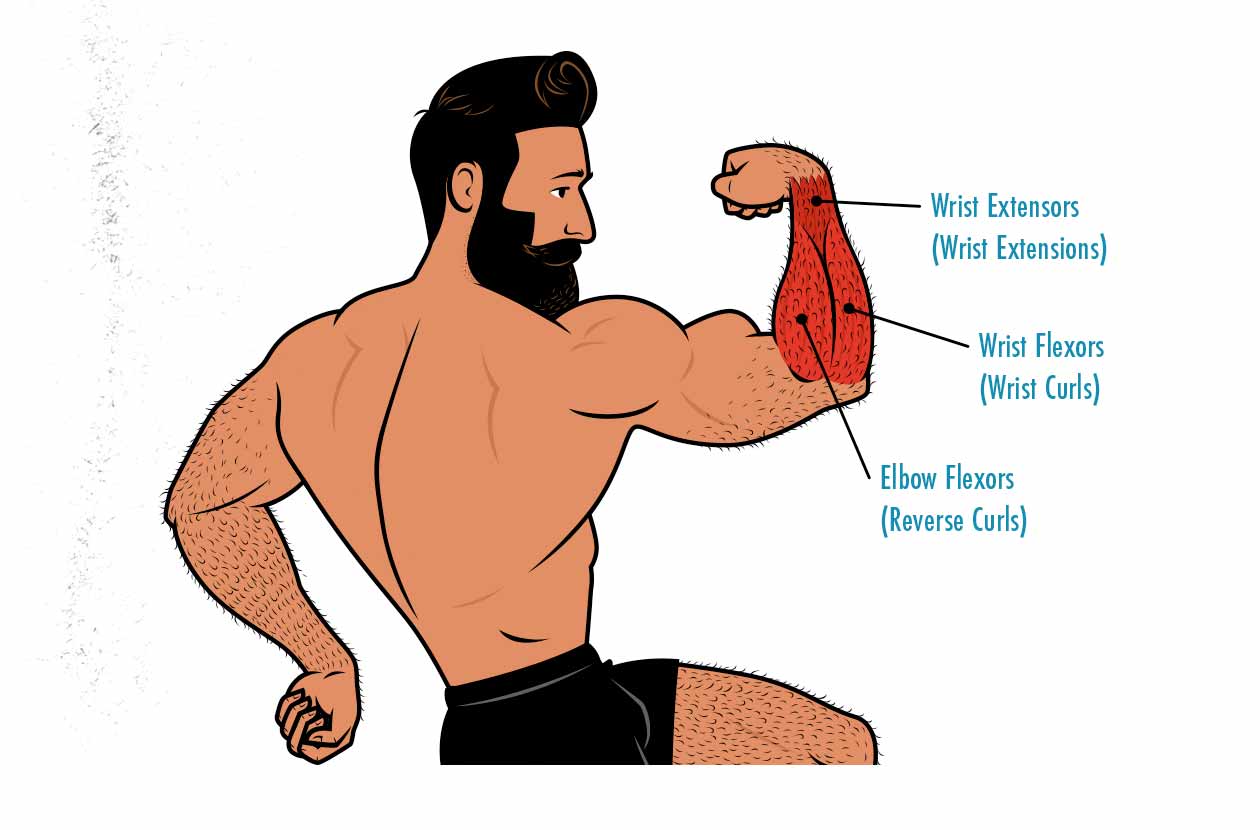
Even so, if you want to maximize the growth of your forearms, it helps to do some dedicated forearm training every once in a while. To work your forearm muscles even harder—and through a deeper range of motion—you can add in some wrist curls:
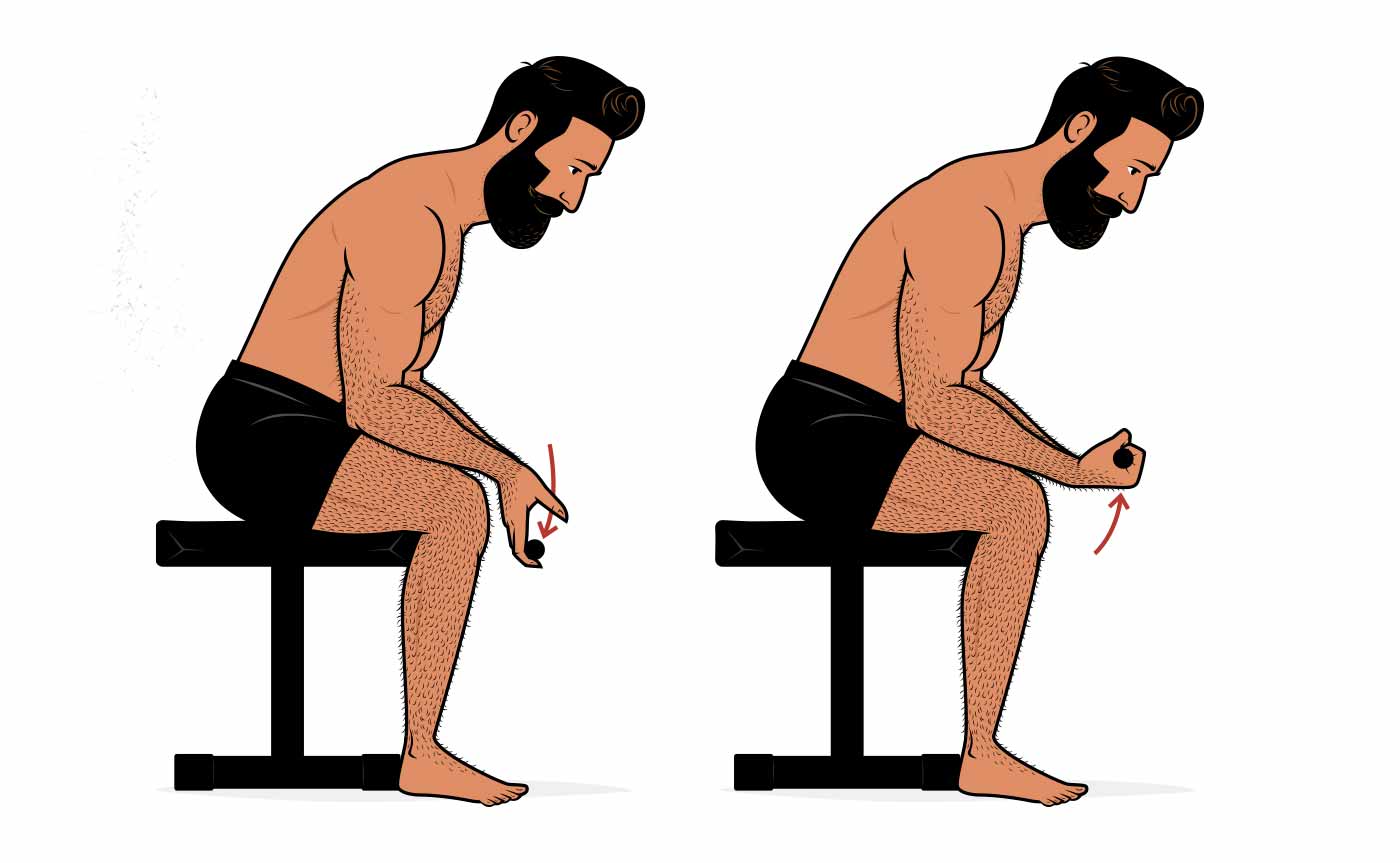
Wrist curls are the main forearm exercise, working our bigger, beefier forearm muscles, but you can also use wrist extensions to bulk up the back side of your forearms. Just keep in mind that if you’ve never trained your forearm extensors before, they might be quite weak. You might need to start by holding weight plates instead of a full 45-pound barbell.
For more, we have a full article on forearm training.
The Calf Raise
The calf raise isn’t technically a barbell exercise, but it exemplifies the principles of barbell training. Start with a weight you can manage (the calf), and lift it 3–4x per week as it grows gradually heavier. With enough time, grit, and food, you’ll soon be able to carry a full-grown bull.
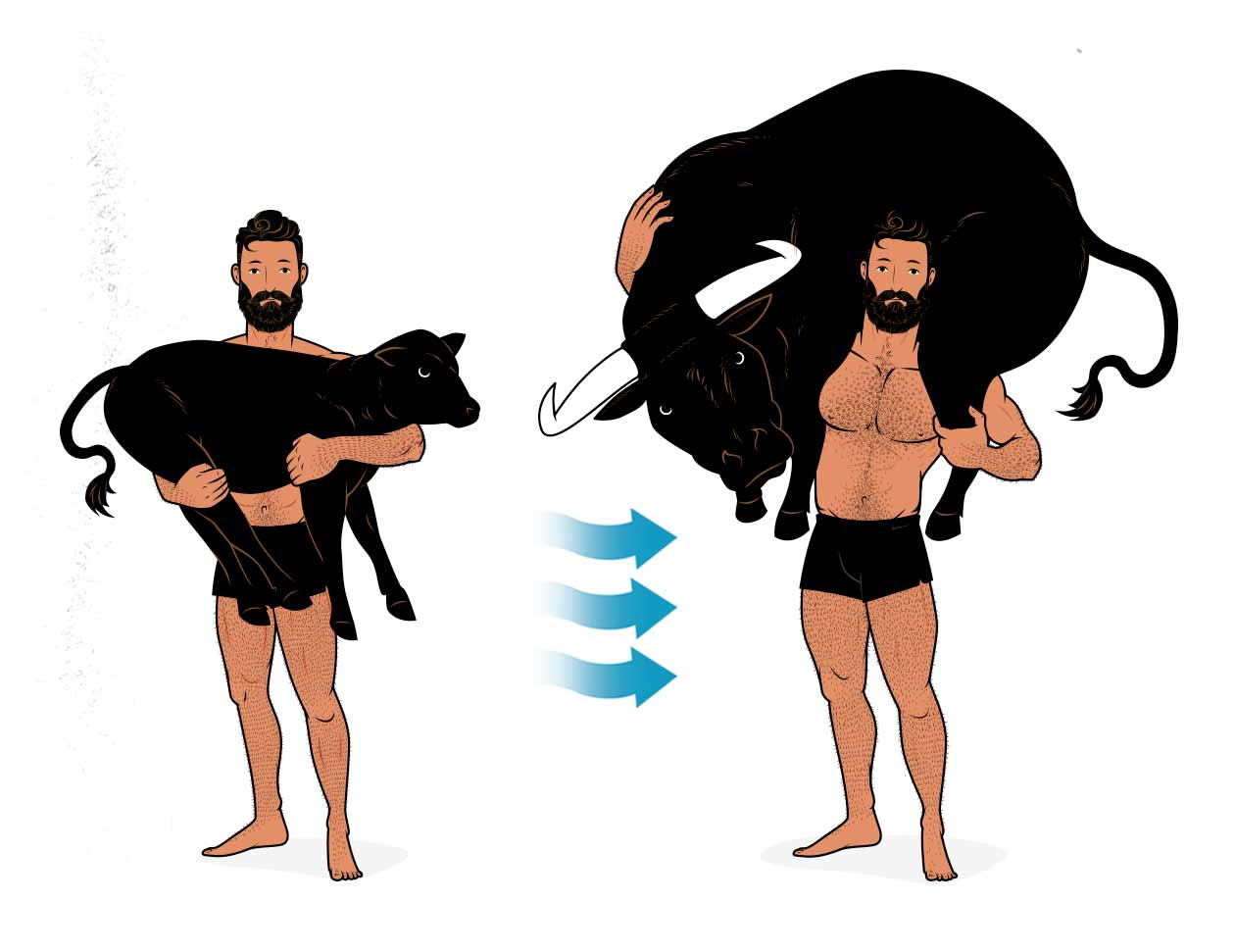
This is less of an exercise and more of a principle of muscle growth. As you build muscle, you’ll need to lift more weight to continue challenging your ever-stronger muscles. For more, we have a full article about progressive overload.
Conclusion
Build your workout routine on a strong foundation of big compound barbell exercises. That will give you at least 2/3 of your overall muscle growth. It will also give you the overall strength and stability you need to do everything else.
- Barbell squat: squats are ideal for your quads and great for your glutes. And if you choose front squats, they’re great for the spinal erectors in your upper back, too.
- Barbell bench press: the bench press is ideal for your chest, good for your shoulders, and okay for your triceps.
- Barbell Deadlift: the deadlift is ideal for your hips and lower back and great for your upper back and hamstrings.
- Barbell Overhead press: the overhead press is ideal for your shoulders, great for our traps, and okay for your triceps.
- Chin-up: chin-ups are ideal for your upper back and great for your abs and biceps.
These big barbell exercises are ideal for bulking up the big muscles in your torso: your glutes, chest, lats, and shoulders. They’re less good at bulking up the smaller muscles in your limbs: your biceps, triceps, forearms, necks, hamstrings, and calves. For those muscles, we have smaller barbell exercises:
- Barbell curl: ideal for your biceps and great for your forearm flexors.
- Barbell skull crusher: ideal for your triceps.
- Barbell Romanian deadlift: ideal for your hamstrings and glutes
- Barbell wrist curls and extensions: ideal for your forearms.
- Neck curls and extensions: ideal for your neck.
The Outlift Barbell Workout Program
If you want a customizable workout program and full hypertrophy training guide, check out our Outlift Barbell Program. It’s designed to help you bulk up with nothing more than your trusty barbell. You can choose between the 3-day or 4-day workout routine, with an easy or hard mode for each. From there, you have dropdown menus where you can pick your preferred barbell exercises.
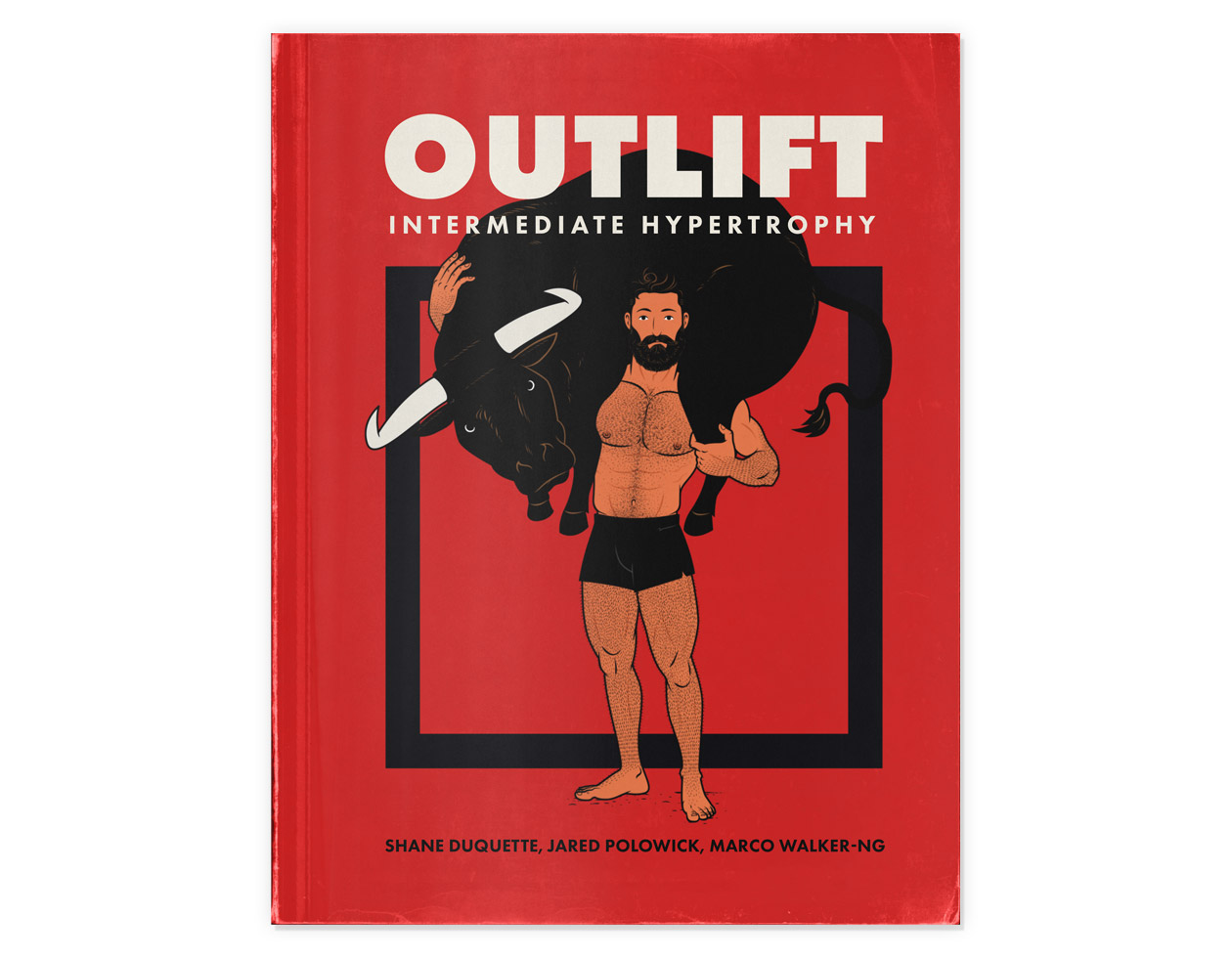
The spreadsheets will then tell you how much to lift for how many sets, ensuring progressive overload as you go through the program. We can also help you track your progress and guide you through the entire progress in our online coaching community.
If you want, you can give it a try. We have a full refund policy if you change your mind.



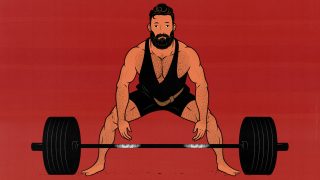
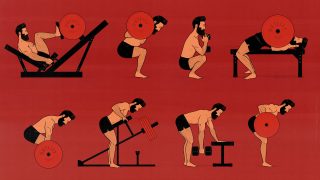
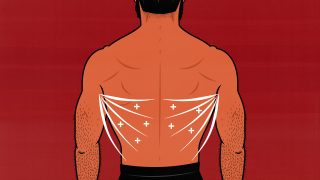
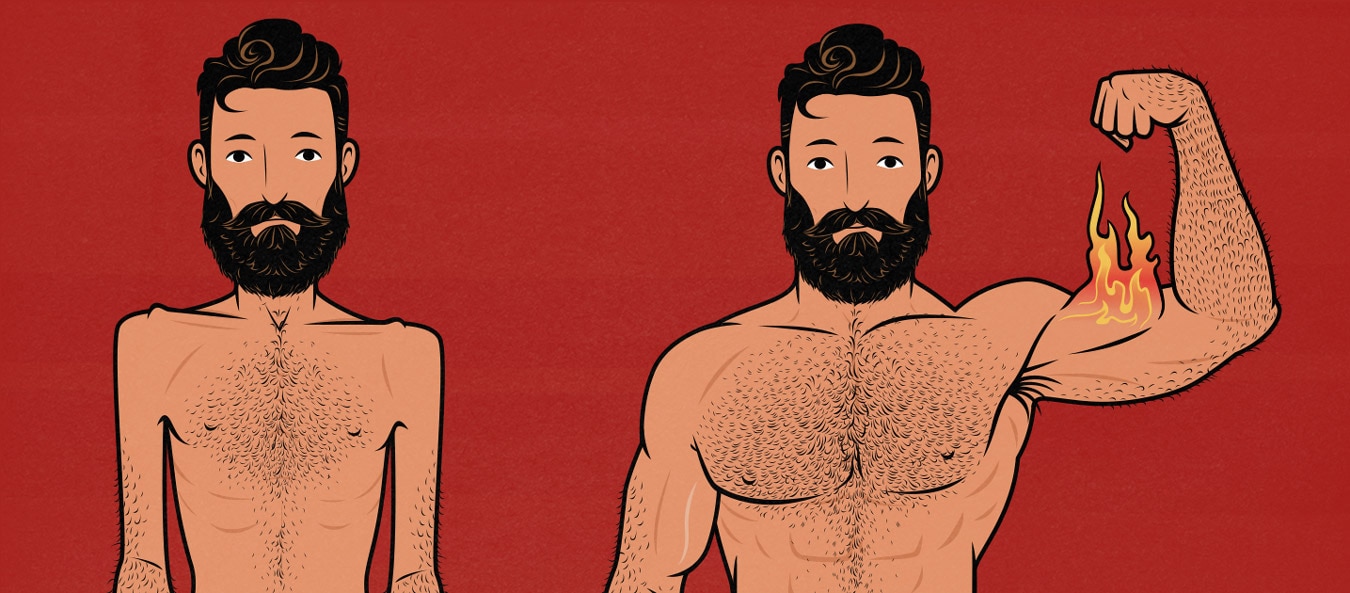
Shane, you may be as passionate about calf training as Omar Isuf!
Fair point. Not very many calves in Toronto, it seems.
Hey Shane, just bought the Outlift program and equipment for a barbell home gym. Super excited to get started with the program, everything looks really great!
How do you feel about the barbell hack squat as an assistance lift for the front squat? Normally, I would use leg presses and leg extensions for assistance and accessory lifts to really blast the quads, but those won’t be an option with my barbell home gym.
I figure since the Zercher squat is more upper back focused, and since split squats and step-ups can only be done one leg at a time, a hack squat would be an efficient quad-dominant assistance lift. However, I noticed the hack squat is not an option within the Outlift program. I have seen you reference the hack squat in other articles, but noticed it is missing from this article as well.
Have you soured on the hack squat recently? Just wondering if there is a reason to avoid doing them. I actually haven’t done them much at all myself at this point because I used other lifts in the past, but I’m looking for different barbell alternatives for each muscle group now, since I will almost exclusively be using my barbell home gym for future workouts.
Thanks!
Sam
Hey Sam, that’s awesome! And thank you 😀
When I mention hack squats, I’m talking about the hack squat exercise machine, not the barbell hack squat. That’s why it’s not on this list of barbell exercises. With that said, though, that’s not because I don’t think it’s a good lift. These are just some good examples. There are plenty of great lifts that aren’t mentioned here.
The barbell hack squat is one of those lifts that some people love, other people find too awkward to challenge themselves with. If you like it, it feels natural, and you’re able to push yourself hard with it, then go for it. It will get the job done 🙂
I prefer Zercher squats, but you’re right, they’re harder on the upper back. That can be good or bad depending on how fatigued your back already is.
Another approach is to use the high-bar squat as your main squat, the front squat as your secondary squat. That way you’ve got two classic squat variations.